

Examples Of The 5 Senses In Writing And How To Use Them
Using the 5 senses in writing can deeply immerse readers in scenes and stories by creating more vivid imagery in their minds. It’s a skill that can elevate books to a higher level. But so often we writers find ourselves lured into the trap of relying on sight and sound. Relying on a narrow range of sensory language isn’t always enough to bring a story to life. We can inject so much more into our stories simply by utilizing sensory details in our writing.
In this guide, we’ll take a look at our sensory organs, why we use vivid writing that appeals to the senses, look at the 5 senses and descriptive writing examples, and ways we can use each sense to elevate our stories to the next level.
Many people experience things through smell, touch, and taste. So appealing to the senses in our writing will enrich our tales and prose with vivid imagery, which is often used to help the reader feel immersed and engaged.
In fact, the oft-forgotten 5 senses are some of the most powerful forms of description, things that can enrich a story and give it life.
And, as we’ll see below, using a sensory description has an incredible ability to connect with us on a psychological level.
Let’s dive in.
Choose A Chapter
What are the 5 senses in the context of writing, why are the five senses important in writing, understanding the science behind sensory description, 5 senses examples from descriptive writing, how to use the 5 senses in writing, 3 exercises to help you use the 5 senses in your writing, a list of helpful adjectives for the five senses, frequently asked questions (faq), what are the five sensory organs.
Before we dive into looking at the 5 senses in a writing context, let’s look at what the five sensory organs are:
- Special receptors in the skin that enable us to touch and feel

Combined, our five senses enable us to learn, experience and create memories. Pepsi Max, for example, always reminds me of my history lessons in college—I’d drink a can during every lesson. Think of songs too. They have an incredible ability to transport us back to moments in our past. Let’s explore things in more detail.
If you’d like to learn more about the basics surrounding the 5 senses, see more examples, or learn how to incorporate sensory description in your writing, see this quick video.
Are There More Than 5 Senses?
Now, something you may be wondering about is whether or not there are more than the 5 classic senses. It is, in fact, believed that there is more than touch, taste, sound, sight, smell. These golden 5 were defined by Aristotle because he could relate them to sensory organs. They are sometimes known as the “five senses folk model”.
But it depends on the manner in which you define a sense.
Newer approaches look at the number of sensory organs we have. And many academics now counter the sixth sense as the vestibular system . This relates to the inner ear and the impact it has on our balance and vision.
But other academics have gone further than this. Some tweak the definition to include sensory receptors. Now the skin, for instance, has at least four sensory receptors, relating to pain, temperature, touch and body awareness (otherwise known as proprioception).
So when someone asks how many senses do we have, it’s all a matter of definition. You can check out this awesome video below by SciShow which explains things in more detail.
Perhaps the main one of the five senses, sight often receives information first and therefore forms our initial judgements.
When it comes to using sight in writing, our stories and characters are often guided by this prime form of description. We describe what our characters see.
However, it would be nigh impossible to describe every aspect of a scene, and even if you did achieve it, nigh impossible to read.
Some of the most acclaimed writers, Charles Dickens, in particular, approached it by picking the right details. The little things that tell us everything. Let’s look at an example of the sense of sight in writing from Great Expectations :
“There was a bookcase in the room; I saw, from the backs of the books, that they were about evidence, criminal law, criminal biography, trials, acts of parliament, and such things. The furniture was all very solid and good, like his watch-chain. It had an official look, however, and there was nothing merely ornamental to be seen. In a corner, was a little table of papers with a shaded lamp: so he seemed to bring the office home with him in that respect too, and to wheel it out of an evening and fall to work.”
This is Jagger’s office. Though he doesn’t feature, we’ve gleaned much about who he is from details like the types of books upon the shelves and the paper-filled table, suggesting he lives a busy, professional life.
Colour is another fantastic tool when it comes to sight. Dickens was known for using colours to portray emotions or themes, such as red for frustration or anger, black for death, white for purity or goodness. Using colour, particularly with themes and the premise , can add extra layers to a story.
We explore some more 5 senses examples below to give you some ideas when it comes to sight.
Writing Prompt
Stand in the middle of your bedroom. Look all around you. Make notes of every little detail you see. Colours, shapes. Crumbs or dust on the floor. The more attentive you can be the better.
Pick out things that could relate to characterisation. The books on a shelf perhaps—what kind of books are they? Are there empty glasses beside your bed, dishes too? All of this helps to build interesting imagery, as well as contribute to other elements of the story, in this instance, characterization .
Sound is incredibly important when it comes to using the 5 senses in our writing. Dialogue dominates many stories, but so often little attention is paid to how characters sound when they talk. It’s strange when you think about how unique people sound, and a person’s voice makes such a difference to how we form views of them.
Something I learned not so long ago is that ducks don’t quack. They tend to grunt or even cackle. It’s easy to assume how things sound, but sometimes what we assume is wrong.
It’s always worth taking the time to research. In doing so you may find new and original ways to describe the sound. Using metaphors and similes, particularly if the sound is unusual, is a great way to bring clarity to descriptions.
Another often overlooked thing is silence. Silence is an excellent tool to set the tone or build an atmosphere or tension . A noiseless forest. A still, foggy street. Eerie.
Either using yourself or ideally, your character, place yourself in a location in which things are happening around you—a park, for instance. Close your eyes and listen.
Make a note of every little sound you hear, from tweeting birds to jackhammers digging up roads. If you can, make a note of how different sounds make you feel. Do fireworks startle you, for instance? Then think about why they could startle you or your character.
Of all the five senses, touch is, in my view, one of the most powerful yet underrated ones. If you can convey touch in an effective way, you’ll reap the rewards.
The scope of this sense depends on the nature of the scene, but imagine, for example, walking barefoot through a forest. The softness of moss between your toes, the cool slime of mud, the pokes and scratches of sticks and stones. Such details can draw readers deeper into the story.
We’ll look at some sensory writing exercises below, but as a brief writing prompt now, close your eyes and pick something up. Describe how that object feels. What features does it have? The texture? Sturdiness? Width? Weight?
These little details can make all the difference when trying to achieve vivid writing that appeals to the senses.
Taste is the more neglected one out of the five sensory organs when it comes to writing. Just like all of the senses, using taste can enrich your story immensely.
How many times have you said the phrase, “It tastes like …”. So many of our memories are tied to tastes. Like I said before, Pepsi Max always reminds me of history classes in college. Which tastes trigger memories for you?
If this happens to us, it happens to your characters too. It’s a great thing to include within your characterization process.
Like smell, taste can serve as a trigger for memories. For example, a husband who shared a love for apple turnovers baked by his deceased wife is reminded of her whenever he eats one.
Taste can also trigger emotions. There’ve been times when I’ve eaten food that tasted so good I bounced with glee in my chair.
A fun one. Head down to your kitchen and finding something to eat that has a bit of texture. Close your eyes, take a bite. Focus closely as you chew, as the food rolls around your mouth, over your tongue and down your throat. How does it taste? How does it make you feel?
We, at last, arrive at smell, though its place is no reflection on its importance when it comes to using the 5 senses in our writing.
The power of smells cannot be underestimated. We smell things all of the time and those scents help to shape our impressions. What can you whiff right now?
A smell helps us to form a judgement on things, such as whether something’s okay to eat. And crucially, smells can trigger vivid memories and emotions, vital tools to any writer.
Here’s one of my favorite 5 senses examples for using smell in writing from James Joyce’s Ulysses :
“ Mr Leopold Bloom ate with relish the inner organs of beasts and fowls. He liked thick giblet soup, nutty gizzards, a stuffed roast heart, liverslices fried with crustcrumbs, fried hencods’ roes. Most of all he liked grilled mutton kidneys which gave to his palate a fine tang of faintly scented urine.”
How Do You Describe The Smell Of Rain In Creative Writing?
The technical term for the smell of rain is “petrichor”.
Rain brings with it a freshness, a crispness, an earthiness. It awakens the scents of other things like dry soil, flowers and grass. It’s something I turn to a lot when writing fantasy , especially in those scenes where characters are moving through rich, rural landscapes.
Similar to the task above which involves a trip out to a busy place, like a park, sit down and have a good sniff. Another good place to try is a coffee shop. Lots of smells of roasting coffee and baking cakes in there.
Importantly, think about where those smells lead you in your mind. Do they trigger memories? Do associated words pop into your mind? From your character’s perspective, this is what their experience would be like too.
This may seem like a straightforward question, but it’s always best to cover the basics before advancing to more technical points.
This style of prose is essentially writing that employs the five senses to create mental images for the reader.
For example, if you want to create a vivid image of a beach, you may describe the smell of seaweed or the grainy texture of sand.
In drawing upon these familiar sensations, we can open the portal wider for our readers to step into the scene, to feel what it’s like to be there. It’s a key part of creative writing in respect of description and something that can elevate your stories.
So that’s what the 5 senses in writing are—they empower your descriptions and help draw readers into the story. Let’s look more at why using them is important.
Here’s a quick video explainer with lots of handy examples:
Using your five senses in your writing is an incredibly powerful way to immerse your reader in the tale.
The more the reader can understand what it’s like to be in your character’s shoes at that precise moment, be it fleeing a demon or marching to war, knowing how it feels and smells like, as well as the visual and audio descriptions, can elevate stories to a whole new level. It quite simply makes it more enjoyable to read.
From a writing perspective, incorporating each of the five senses in your writing at appropriate moments is something your readers will love.
From the perspective of the fantasy writer specifically, using the 5 senses is a terrific way to reveal the details created during your worldbuilding process.
This is especially useful when you’re trying to convey unique imagery or something that’s altogether alien to the reader. It’s something I used a lot when writing Pariah’s Lament and readers loved it. This is just one of the many 5 senses examples you’ll find below.
We’ve covered a lot about using sensory descriptions and how they can elevate your writing to the next level. However, there are a lot of scientific studies that back up the theory.
For instance, in a study published back in 2011 by The Quarterly Journal of Experimental Psychology, it was found that we process certain words faster than others if there is a sensory experience attached to them.
Such studies aren’t new. In fact, Miller and Johnson-Laird (1976) examined how fundamental “word-percept associations” are to our language. This was expanded upon n a 2003 study by Rakova who emphasised a very important point—that the purpose of language is to express how we feel, what we see, hear, smell and taste.
Another study on sensory linguistics (which looks at how language relates to the senses), published by the University of Birmingham , examined humanity’s dependence on perceptions and how we interact with the world through feeling, seeing, tasting, hearing and smelling.
What we can see here is a growing understanding of the power and influence of a piece of sensory description. By examining these studies, writers can find a whole new appreciation for using the 5 senses in writing.
Let’s move on to look at the 5 senses and descriptive writing examples. As we’ve seen above, vivid imagery is often used to help the reader feel immersed in the story. So in this section, I’ve provided some from some bestselling books that make great use of the 5 senses, as well as some examples from my own novel.
“The tearing of flesh, as though a butcher were yanking meat from a flank. The bubbling of liquids and the soft rasping of the cutting tools.” Tooth & Nail , Ian Rankin
“Stars spun across his vision and his head felt as if it were about to burst… With difficulty, Hanno undid the chinstrap and eased off his helmet. Cool air ruffled his sweat-soaked hair.” Hannibal: Fields of Blood Ben Kane
“A cold wind was blowing out of the north, and it made the trees rustle like living things. All day, Will had felt as though something were watching him, something cold and implacable that loved him not.” A Game of Thrones, George RR Martin
“It was dark and dim all day. From the sunless dawn until evening the heavy shadow had deepened, and all hearts in the City were oppressed. Far above a great cloud streamed slowly westward from the Black Land, devouring light, borne upon a wind of war; but below the air was still and breathless, as if all the Value of Anduin waited for the onset of a ruinous storm.” The Return Of The King , JRR Tolkien.
This last one for me is a great example of a descriptive paragraph using the five senses. From the off, you not only get a vivid image of the setting (dark, dim, sunless dawn), but you can feel what it’s like to be there on an emotional level (hearts in the City were oppressed). Our senses are further teased with the description of a “still and breathless” air.
I wanted to provide you with a few more examples of descriptive paragraphs that use sensory details from my own novel, Pariah’s Lament to give you an idea of how these principles can be used in practice. The idea is to add little details to paint a more vivid picture so that you can almost feel there in the scene.
Let’s start with a 5 senses paragraph example:
The mud of the road sucked at her tattered leather boots, a quagmire after incessant rains. Autumn circled like a hawk. The wind grabbed at her woollen green cloak and homespun dress. The hand-me-downs from her cousins never fitted, always too wide at the waist and short of length. She pulled her cloak tight about her, bundling it around her hands to keep away the biting chill.
The ringing gave way to those crashes and bangs, each one coming with the beat of his heart. His eyes flickered open. Slate-grey clouds hung above. Dust hovered in the air, rocks and debris showered down upon him. He raised his throbbing head and looked around. Men and women, hands over their ears, cowered down behind the crenellations of the wall, fear etched upon their faces, consuming their eyes, paralyzing their bodies. A few defiant individuals continued to loose arrows. For many, it was the last they shot. The Karraban thunder smashed the parapets to bits, obliterated siege engines, battered the cliff behind them and knocked from it great chunks of rock that tumbled down to crush those below. The ringing in Jem’s ears eased enough for him to hear the screams. They became the backdrop to the rumbling of the Karraban thunder. Only one thought entered Jem’s mind: flee.
The bells rang loud and panicked across Yurrisa. Hidden in the shadows of the abandoned warehouse, Edvar and the others lay in wait. He peered through a crack in a boarded window at the cobbled street. Echoing along it came a shout. Another. Steps rushed toward him, and into view burst a group of soldiers, breaths billowing mist in the cold morning air.
Laughter rippled from the table behind Edvar. The three men were tanners, the least difficult of all working men to identify: stained clothes and hands and stinking of a peculiar cocktail of rotten flesh and mint. They rubbed themselves with the latter to mask the stench of the former. Nobody could bear their presence long enough to tell them it didn’t work.
A Quick Exercise For Finding Good Examples Of The 5 Senses In Writing
If you’d like to find more sensory description examples, I recommend doing this simple exercise:
Pick up any book that you see, one ideally that you don’t mind marking with a pen or highlighter. Next, scan the pages, looking for descriptive scenes. Whenever you see a sentence that refers to any of the five senses, highlight it in some way.
The benefit of doing this is that you get examples from a variety of different writers, each with their own clever way of making their exposition more immersive.
Something you may notice is that many of them employ metaphors and similes to help you build a visual image in your mind. This is a very effective way of using the 5 senses in writing. You could say things like:
- The water smashed into the ground like the tide hitting a rocky coast
- A squeal filled the air like a pig fearing slaughter
- It smelled like an overflowing latrine pit sat in the baking sun
You can learn more about using metaphors and similes in this guide on writing prose.
Discover More Examples Of Descriptive Writing Using The 5 Senses
If you’re looking for more 5 senses examples for your writing, one of the best things you can do is to read books that pay particular attention to this. One of the standout books that explore this is Blindness by José Saramago.
There’s no shortage of sensory language examples out there for you to study. From books to writing guides like this, there are plenty of helpful resources you can learn from.
If you re-read some of your favourite books there’ll no doubt be passages where the writer employs a sight and smell or taste or touch to great descriptive effect. Oftentimes they employ simple but effective techniques (which we’ll cover below) that draw you deeper into the scene, so much so that you feel as if you’re there.
Often some of our favourite books are those that use to great affect the five senses. Books that transport us to new worlds and take us on epic adventures. And so often it’s the vivid descriptions that draw us in and help us walk amongst the characters.
We’ll look at some examples of the 5 senses in writing below that illustrate just how effective they can be further on below. But first, let’s look at why this is all so important.
How Do You Achieve Vivid Writing That Appeals To The Senses?
As we know, vivid writing that appeals to the senses has the ability to transform your story from something flat and full into something rich, comepelling and irresistable to read. It’s not an easy thing to do, but that’s why this guide exists, to show you and share my insights from 10 years’ experience writing.
Here are three the most useful and simplest tips I’ve come across over the years to help you achieve more vivid writing that uses the senses.
- Practise – it sounds simple but one of the best ways to get used to including the 5 senses in your writing is to practise. Below, you can find lots of handy exercises that can help you sharpen your writing skills.
- Reading – another very effective method of sharpening your usage of the five senses in your writing is to simply read the works of top-class authors. These talented writers can use small details that appeal to the senses and immerse you in the story.
- Explore – to boost your vocabulary when describing scenes, characters and feelings with the senses, it helps to go out and explore the world and absorb what it is you’re trying to convey. For example, if you need to describe the feeling of the bark of a tree, going out and examining and touching the different trees around you can help you come up with ideas for describing textures, smells and unique visual descriptions. Imagine stumbling across something like this below, for example. Have a go at describing the rich detail using each of the senses.

How Do I Use The 5 Senses To Write About Feelings And Emotions?
It’s difficult to describe how a character feels. People are complex beings and at the best of times, we can’t make sense of how we think and feel about a given thing.
When writing, using the 5 senses can open up doors into the minds of our characters. In utilising them, we can avoid simply telling the reader what our character is feeling, (like, “he felt sad”) and instead, we can suggest or show it through the likes of body language, like how their shoulders are (sagging or raised).
Here are some more examples of the 5 senses when describing emotion:
- Sight – If, for example, your character is feeling a little down, you could focus on describing the way they interpret the world around them, such as focusing on the grey clouds hanging low in the sky, the wilted flowers in the garden, or the empty chair across the room.
- Sound – Incorporating sounds can help to create an atmosphere that resonates with your readers. Let’s say your character is feeling anxious. You could describe the ticking clock, the distant sirens, the creaking floorboards—things that increase the tension.
- Touch – A powerful method is to use tactile descriptions to help your readers feel what the character is feeling. For example, if your character is feeling nervous, you can describe their clammy hands, the beat of their heart in their ears, the tightness in their chest.
- Taste – Using taste really adds depth to your descriptions of emotion. If your character is feeling joyful, you could describe the sweetness of a ripe strawberry, the richness of a dark chocolate truffle, or the effervescence of champagne bubbles. Linking these things back to memories can also help to trigger a more powerful reaction. For instance, the taste of a an Indian curry that you had the night you proposed to your wife.
- Smell – Scent can also help to create a visceral experience for your readers, one that relates to them on a more emotional level. If your character is feeling nostalgic, you can describe the aroma of freshly baked cookies, the salty sea air, or the musky scent of old books.
By using the five senses in your writing you can create a multi-dimensional experience for your readers, making your characters and their emotions more real and relatable. Let’s take a look at just how powerful sensory details are when it comes to painting a picture in the reader’s mind.
Use A Checklist To Help You With Writing With The Senses
Something I’ve done to improve my use of the 5 senses in my writing is to include them within the planning process. It’s good to save it until the end when you’ve plotted out your story or chapter, however.
What I do is read over the plan and try and place myself in the scenes. Working my way through each sense, I list everything that pops into my head.
- It’ll be unlikely that you need to spend too much time on sight , but taking the time to consider things in detail can provoke new and unique ideas. What little details can be included? Remember the power of specificity.
- Next, onto sounds . Like sights, it’s unlikely you’ll need to spend too much time on this but it’s always helpful to consider the likes of characters’ voices and any usual sounds that could be featured.
- Smells . When it comes to smells a good starting point is to list everything that comes to mind, even mere whiffs, which can be the most telling of all. Smells can provoke memories and emotions too, like the smell of perfume could remind a character of their dead lover, and that leaves you open to describe emotions.
- What can your character touch or feel? How does the hilt of the sword feel in your character’s fingers? How does the touch of a vivacious woman feel to your lonely character? What information can be gleaned from the manner of a handshake?
- Lastly, what tastes , if any, can you include? Is your character eating? Can they taste blood after being punched in the cheek? Do they enter a room where the smell is so foetid they can taste it?

Here are a few useful exercises to get into the swing of using the senses. The more you practice, the more it’ll become ingrained in the way you write and that’s why it’s one of my favorite writing tips of all!
- One place, one sense . As the title suggests, think of a place and describe everything you can using just one sense. Challenge yourself. Pick a sense you feel you struggle with. Or do one sense, then a different one.
- Describe an object using the 5 senses. This is a nice simple exercise. Pick one object and describe it using all of your senses. Examples of objects could be chocolate (so you can taste) or a bottle of perfume (for the smell!).
- Close your eyes and pick an object up. This one was mentioned above, but it’s a powerful tool. Jot down everything you can think of.
- Pick your favourite food and eat! This one’s a bit more fun. Take chocolate for example. Savour each bite and write down everything, from taste to texture, the sounds of it breaking in your mouth, and importantly, how it makes you feel.
- Pick something alien and try to use sensory descriptions. This is a great way to challenge your use of the 5 senses because you have to create everything from scratch and to a whole new level of detail. So if you’re a sci-fi writer, this could be a great way to learn how to describe a spaceship in writing.
Here’s a brilliant visual exercise too which I highly recommend trying. It’s quick, and easy and really does hone your skills when it comes to using the 5 senses in writing.
1. Walk And Write
This exercise I call walk and write . Take a notepad and write five headings: sight, sound, touch, taste, and smell. The next time you go out, even if it’s just to the shop on the corner, write down everything you experience. The touch of the rain or breeze, how the pavement feels underfoot, snippets of passing conversation you hear, the whistle of birds, how that warm and crispy sausage roll tastes. *Warning* You may look odd stopping all the time.
Here’s a step-by-step guide:
- Take a walk outside and observe your surroundings. Use your senses to take note of what you see, hear, smell, taste, and touch. Write down your observations.
- Choose one of the things you noticed on your walk and use it as a prompt for your writing. For example, if you noticed the sound of birds chirping, write a descriptive paragraph that captures that sound.
- As you write, be sure to use sensory language to bring your description to life. Instead of simply saying “I heard birds chirping,” try something like “The melody of birdsong filled my ears, each chirp a delicate note in a symphony of nature.”
- Repeat this exercise for each of the senses. Choose a different observation each time and challenge yourself to use vivid sensory details to paint a picture with your words.
2. Write A Short Story With The 5 Senses
One of the most effective ways that you can sharpen your sensory description writing is to write a short story with the 5 senses.
The way it works is simple. Plan out your story—characters, plotting, theme—and then when it comes to the writing, you’re only permitted to use the five senses.
It can help to think of a story in which you’d likely use the sensory organs more than usual. Let’s look at a few writing prompts:
- Your protagonist awakens in a dark cave. It’s cold and damp. They must figure out what’s happened and find their way out.
- Your protagonist is fleeing through a forest. What are they running from? What awaits them up ahead?
- Your character is upon a ship and is knocked overboard. How do they survive in the turbulent waves?
These are just a few prompts that are specifically designed to help you use the five senses in your writing. Trust me, an exercise like this will have your skillset sharpened in no time.
3. Use 5 Senses Writing Prompts
Here are some 5 senses writing prompts that may help you get started:
- You’re at home, watching TV. You catch the scent of something. Something that makes you mute the TV, look around, stand up. What is it you smell?
- For three days you’ve been travelling alone through the woods. You’re two days from your destination. Tired, weary. And you’re pretty sure something is following you. The sun has long since set. The embers are dying in your fire. And you begin to hear sounds close by…
- You’ve just started a new job. The office is big, labyrinthine. On your way back from lunch on your first day, you get lost. You open a door with stairs leading down. You follow them. Get further lost. And the steps give way. You awake in darkness to the sound of something growling. You reach for your phone, turn on the torch…
There are a few examples of sensory language-based writing prompts for you. See where they take you.
You can never have enough adjectives to help you describe the five senses. Below, you can find a pretty simple list, but it serves as a great starting point. From there you can add some of your own examples of using the 5 senses in descriptive writing. I also have some other helpful writing tools here that you may find useful.
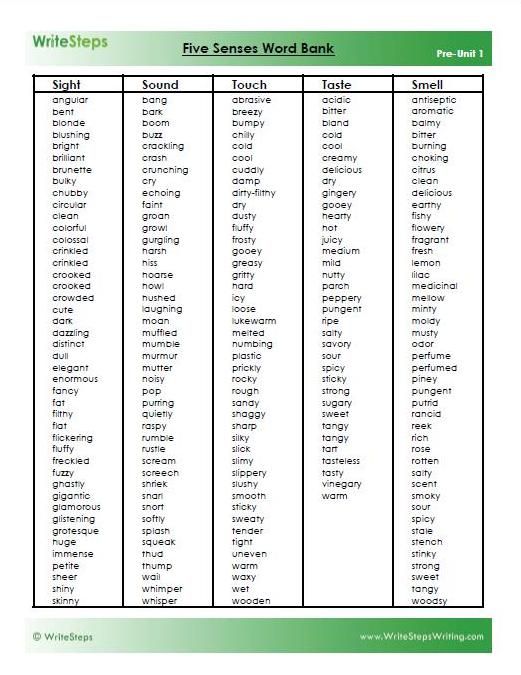
Below, you can find answers to some commonly asked questions when it comes to sensory descriptions, as well as more descriptive writing examples using the 5 senses.
“The icy wind rattled the ancient shutters upon the windows, stirring a shudder and setting every hair on her body on edge.”
This sentence uses sensory language to describe not just how the setting looks (from the rattling ancient shutters we see it’s an old possibly abandoned house), and crucially, we get a sense of how it feels to be in that setting, which is the main objective. It feels eerie, we feel the cold. We’re spooked.
Sensory description in fiction writing requires a writer to utilise the 5 senses – sight, sound, touch, taste and smell.
Incorporating the senses into your writing is simple. First, focus on what your characters can see in the scene. Then, one by one, think about what they can hear, smell, feel and taste. Assort your various descriptions and pick out your most powerful few.
The five senses are often used to draw a reader deeper into the scene, to feel closer to the characters. Writers do this by adding extra details focusing on the likes of touch and smell. This vivid writing that appeals to the senses can help immerse readers in our tales.
The best way is to pick up your favourite book and highlight any sentences or paragraphs that utilise the 5 senses. You’ll then have a bank of sensory details examples to call upon whenever you need them.
A sensory description is one that includes sight, sound, touch, smell and taste. Exploring sensory language examples gives you a greater ability to immerse your readers in the story and experience what the characters feel.
If you have any questions or need more examples of the 5 senses in writing, please contact me.
- Recent Posts
- Mastering Dialogue: The Very Best Tips - January 12, 2024
- The Proven Method Of Writing Short Story Cover Letters - November 10, 2023
- Tips, Advice And Guidance On Writing Villains And Antagonists - November 7, 2023
Related Posts

What Is NaNoWriMo? Get A Complete Understanding

11 Essential Ways To Stop Procrastinating

No thanks, close this box
Descriptive Essay Writing
Descriptive Essay Examples

Amazing Descriptive Essay Examples for Your Help
Published on: Jun 21, 2023
Last updated on: Mar 1, 2024
-8521.jpg)
People also read
Interesting Descriptive Essay Topics - 2024
Writing a Descriptive Essay Outline - Tips & Examples
Descriptive Essay: Definition, Tips & Examples
Share this article
Descriptive essays are very commonly assigned essays. This type of essay enhances students' writing skills and allows them to think critically.
A descriptive essay is often referred to as the parent essay type. Other essays like argumentative essays, narrative essays, and expository essays fall into descriptive essays. Also, this essay helps the student enhance their ability to imagine the whole scene in mind by appealing senses.
It is assigned to high school students and all other students at different academic levels. Students make use of the human senses like touch, smell, etc., to make the descriptive essay more engaging for the readers.
On This Page On This Page -->
Examples make it easy for readers to understand things in a better way. Also, in a descriptive essay, different types of descriptions can be discussed.
Here are some amazing examples of a descriptive essay to make the concept easier for you.
Descriptive Essay Example 5 Paragraph
5 paragraphs essay writing format is the most common method of composing an essay. This format has 5 paragraphs in total. The sequence of the paragraphs is as follows;
- Introduction
- Body Paragraph 1
- Body Paragraph 2
- Body Paragraph 3
- Conclusion
Following is an example of a descriptive essay written using the famous 5 paragraph method.
5 Paragraph Descriptive Essay

Get More Examples From Our AI Essay Writer
Descriptive Essay Example About A Person
Descriptive essays are the best option when it comes to describing and writing about a person. A descriptive essay is written using the five human senses. It helps in creating a vivid image in the readerâs mind and understanding what the writer is trying to convey.
Here is one of the best descriptive essay examples about a person. Read it thoroughly and try to understand how a good descriptive essay is written on someoneâs personality.
Descriptive Essay Example About a Person
Descriptive Essay Example About A Place
If you have visited a good holiday spot or any other place and want to let your friends know about it. A descriptive essay can help you explain every detail and moment you had at that place.
Here is one of the good descriptive essay examples about a place. Use it as a sample and learn how you can write such an essay.

Tough Essay Due? Hire Tough Writers!
Descriptive Essay Example for Grade 6
Descriptive essays are frequently assigned to school students. This type of essay helps the students enhance their writing skills and helps them see things in a more analytical way.
If you are a 6 grader and looking for a good descriptive essay example, you are in the right place.
Descriptive Essay Example for Grade 7
Here is one of the best descriptive essay examples for grade 7.
Descriptive Essay Example for Grade 8
If you are looking for some amazing descriptive essay examples for grade 8, you have already found one. Look at the given example and see what a well-written descriptive essay looks like.
Descriptive Essay Example for Grade 10
Essay writing is an inevitable part of a student's academic life . No matter your grade, you will get to write some sort of essay at least once.
Here is an example of a descriptive essay writing for grade10. If you are also a student of this grade, this example might help you to complete your assignment.
Descriptive Essay Example for Grade 12
If you are a senior student and looking for some essay examples, you are exactly where you should be.
Use the below-mentioned example and learn how to write a good essay according to the instructions given to you.
Descriptive Essay Example College
Descriptive essays are a great way to teach students how they can become better writers. Writing a descriptive essay encourages them to see the world more analytically.
Below is an example that will help you and make your writing process easy.
College Descriptive Essay Example
Descriptive Essay Example for University
Descriptive essays are assigned to students at all academic levels. University students are also assigned descriptive essay writing assignments. As they are students of higher educational levels, they are often given a bit of difficult and more descriptive topics.
See the example below and know what a descriptive essay at the university level looks like.
Short Descriptive Essay Example
Every time a descriptive essay isn't written in detail. It depends on the topic of how long the essay will be.
For instance, look at one of the short descriptive essay examples given below. See how the writer has conveyed the concept in a composed way.
Objective Descriptive Essay Example
When writing an objective description essay, you focus on describing the object without conveying your emotions, feelings, or personal reactions. The writer uses sight, sound, or touch for readers' minds to bring life into pictures that were painted by words.
Here is an example that you can use for your help.
Narrative and Descriptive Essay Example
A narrative descriptive essay can be a great way to share your experiences with others. It is a story that teaches a lesson you have learned. The following is an example of a perfect narrative descriptive essay to help you get started.
Paper Due? Why Suffer? That's our Job!
How to Start a Descriptive Essay? - Example
If you don't know how to start your descriptive essay, check this example and create a perfect one.
How to Start a Descriptive Essay - Example
Subjective Descriptive Essay Example
It is a common concept that a descriptive essay revolves around one subject. Be it a place, person, event, or any other object you can think of.
Following is one of the subjective descriptive, easy examples. Use it as a guide to writing an effective descriptive essay yourself.
Writing a descriptive essay is a time-consuming yet tricky task. It needs some very strong writing, analytical, and critical thinking skills. Also, this is a type of essay that a student can not avoid and bypass.
But if you think wisely, work smart, and stay calm, you can get over it easily. Learn how to write a descriptive essay from a short guide given below.
How to Write a Descriptive Essay?
A writer writes a descriptive essay from their knowledge and imaginative mind. In this essay, the writer describes what he has seen or experienced, or ever heard from someone. For a descriptive essay, it is important to stay focused on one point. Also, the writer should use figurative language so that the reader can imagine the situation in mind.
The following are some very basic yet important steps that can help you write an amazing descriptive essay easily.
- Choose a Topic
For a descriptive essay, you must choose a vast topic to allow you to express yourself freely. Also, make sure that the topic you choose is not overdone. An overdone will not grab the attention of your intended audience. Check out our descriptive essay topics blog for a variety of intriguing topic suggestions.
- Create a Strong Thesis Statement
A thesis statement is the essence of any academic writing. When you select the descriptive essay topic, then you create a strong thesis statement for your essay.
A thesis statement is a sentence or two that explains the whole idea of your essay to the reader. It is stated in the introductory paragraph of the essay. The word choice for creating the thesis statement must be very expressive, composed, and meaningful. Also, use vivid language for the thesis statement.
- Collect the Necessary Information
Once you have created the thesis statement and are done writing your essay introduction . Now, it's time to move toward the body paragraphs.
Collect all necessary information related to your topic. You would be adding this information to your essay to support your thesis statement. Make sure that you collect information from authentic sources.
To enhance your essay, make use of some adjectives and adverbs. To make your descriptive essay more vivid, try to incorporate sensory details like touch, taste, sight, and smell.
- Create a Descriptive Essay Outline
An outline is yet another necessary element of your college essay. By reading the descriptive essay outline , the reader feels a sense of logic and a guide for the essay.
In the outline, you need to write an introduction, thesis statement, body paragraphs and end up with a formal conclusion.
Proofreading is a simple procedure in which the writer revises the written essay. This is done in order to rectify the document for any kind of spelling or grammatical mistakes. Thus, proofreading makes high-quality content and gives a professional touch to it.
You might be uncertain about writing a good enough descriptive essay and impress your teacher. However, it is very common, so you do not need to stress out.
Hit us up at CollegeEssay.org and get an essay written by our professional descriptive essay writers. Our essay writing service for students aims to help clients in every way possible and ease their stress. Get in touch with our customer support team, and they will take care of all your queries related to your writing.
You can always enhance your writing skills by leveraging the power of our AI essay writing tools .
Place your order now and let all your stress go away in a blink!
Barbara P (Literature)
Barbara is a highly educated and qualified author with a Ph.D. in public health from an Ivy League university. She has spent a significant amount of time working in the medical field, conducting a thorough study on a variety of health issues. Her work has been published in several major publications.
Paper Due? Why Suffer? That’s our Job!

Keep reading

Legal & Policies
- Privacy Policy
- Cookies Policy
- Terms of Use
- Refunds & Cancellations
- Our Writers
- Success Stories
- Our Guarantees
- Affiliate Program
- Referral Program
- AI Essay Writer
Disclaimer: All client orders are completed by our team of highly qualified human writers. The essays and papers provided by us are not to be used for submission but rather as learning models only.
404 Not found
My Speech Class
Public Speaking Tips & Speech Topics
Descriptive Essay – Best Tips & Examples

Amanda Green was born in a small town in the west of Scotland, where everyone knows everyone. I joined the Toastmasters 15 years ago, and I served in nearly every office in the club since then. I love helping others gain confidence and skills they can apply in every day life.
So, your professor asked you to write a five-paragraph essay to describe a topic. How do you get started? A descriptive essay is the kind of written paper that gives a vivid image of any subject. It should be clear, illustrative, and free from bias.
My guide will show you how to write a descriptive essay using the best tips and examples. Learn how to give a vivid picture of something and leave an impression on your readers.
What Is a Descriptive Essay?

A descriptive essay belongs to a genre of essays that creates a vivid reading experience for readers. It aims to describe a person, process, event, place, object, or concept.
When describing a person, you can write about their personality, appearance, behavior, and mood. But when your topic of choice is an event, consider what happened, who was there, and where it took place.
This essay usually appeals to the five senses: sight, touch, smell, hearing, and taste. For example:
Not descriptive : Jane should cut her hair.
Descriptive : Jane’s hair is long and strawberry blonde.
Can We Write Your Speech?
Get your audience blown away with help from a professional speechwriter. Free proofreading and copy-editing included.
However, not all descriptions are descriptive essays. Descriptions are just simple paragraphs or sentences with no firm structure. A descriptive essay should include an introduction, at least three body paragraphs, and a conclusion.
What Makes a Good Descriptive Essay?
The basis of an excellent descriptive essay isn’t your topic but how you write it. Make sure the following components are included in your writing.
An Interesting Introduction
The introductory paragraph introduces your topic and other contexts that the reader needs to understand your work. Keep it clear to your audience that the essay is meant to focus on description instead of arguments or persuasion.
For example, if you’re writing an essay about climate change, don’t try to argue why climate change is real. Instead, focus on vivid descriptions of the phenomenon. Provide a little background information while keeping it concise.
The most important part of your descriptive essay is the thesis statement. This sentence is the key to strong writing. It summarizes your paper and provides a purpose to it.
Keep your essay objective but interesting. Add a hook statement that will grab the reader’s attention. Then, provide additional details about what you will explain or describe in the following paragraphs.
Detailed Body Paragraphs
After providing the descriptive essay thesis statement, it’s time to practice your critical thinking skills and dive deeper into the body paragraphs.
Writing on academic levels will require you to cover at least three points with formal descriptions. But when writing about a personal experience or any form of creative writing, you can use literary images and tell a story with only one body paragraph.
Every body paragraph should have a topic sentence. When writing about a place, the first body paragraph can discuss its architectural style. For instance, you can say, “The Sydney Town Hall is a manifestation of Victorian architecture.”
Then, support your topic sentence with more descriptions. Ask yourself, how does The Sydney Town Hall represent Victorian architecture?
This part is where you include sensory details. For example, “The Sydney Town Hall has a sophisticated brick and stone structure.” You can add factual information to your body paragraphs, such as “It is inspired by the French Second Empire Hôtel de Ville in Paris.”
Include transitional devices to connect each sentence and let the paragraphs flow smoothly without jumping from one idea to another.
When you gather data from another writer’s work, cite them appropriately. Check the citation style recommended by your professor so you can credit their work and avoid plagiarism.
Short Conclusion
Your entire essay wouldn’t be complete without a good-quality conclusion. Once you’ve painted a memorable image of something through the paragraph, tie it all together in one paragraph.
This part of the essay contains the last few lines that provide meaning to your thesis statement. Use it to leave an impression on your readers.
Your approach to the conclusion should be clear and concise. What is the initial purpose of your work? What is the importance of the details you provided throughout the paper? Reflect on these questions and prepare the audience for the clincher statement.
Finish the entire essay with a thought, quote, or question.
Descriptive Essay Tips
Now that you know the parts of a descriptive essay, here are some tips for writing an essay of this type.
Be Specific With Your Topic of Choice
As a professional writer, the subject matter for your descriptive essays should be specific and clear. Before looking for a topic and creating an essay outline, try setting an objective for your paper. Why do you want to describe an event to your readers vividly?
Once you’ve found your purpose, determine which event, object, person, or idea you want to give a vivid picture of. If it’s a college essay, check the requirements of the professor.
Use Figurative Language
You can make complex descriptions of your topic in non-literal ways. Incorporating figurative language in the essay writing process will give you a creative edge when discussing even the simplest thing.
Understanding similes, metaphors, hyperboles, and other figures of speech are a few descriptive essay writing skills you should master for a flawless essay. Consider this example.
Instead of : We ran fast.
Try : We ran like greased lightning.
“We ran like greased lighting” is more interesting and will stick in your readers’ minds. This is an example of hyperbole, as it indicates an exaggerated statement or claims not taken literally.
However, if you’re producing academic writing, avoid excessive use of figurative language. For example, you should never use metaphors or an analogy to base the foundation of your content.
Keep your abstract writing to an occasional concept sprinkled into your text. Not every sentence requires a figure of speech.
Use Your Senses
Descriptive essay writing will require you to use your five senses. This type of essay will help you explore your sense of taste, sight, touch, smell, and sound.
For example, when describing your favorite life memory, a complete description may include the appearance of the buildings, the laughter of your friends, the smell of the flowers, and the taste of ice cream during that day.
Try creating a table divided into five senses and list each sensation or feeling associated with your topic. These details will help you support your thesis before outlining them.
Here’s an example of a part of an essay about fear with an in-depth physical description.
Instead of : Cameron feels scared.
Try : In a complete state of silence, Cameron curled her hands into tight fists as the room started smelling like his late grandmother’s perfume.
Make an Outline
Whether it’s a narrative essay or an argumentative essay, all kinds of essays require a specific format to guide the entire process. Once you’ve got your senses right, it’s time to look for suitable descriptive essay outlines.
Essay outlines are vital because they simplify the essential components of your paper. They organize your ideas, save time, and prevent writer’s block.
The most common is a five-paragraph essay format, which includes an essay introduction, a strong thesis statement, three body paragraphs, and your conclusion. This format is also the standard essay for college students.
Below is a descriptive essay outline sample about camping.
- Introduction paragraph: Camping is challenging because of situations we can’t control.
- Body paragraph 1: Bad weather
- Body paragraph 2: Wildlife encounters
- Body paragraph 3: Equipment failure
- Concluding paragraph: Restate points
Choose the Right Words
The essay writing process is trickier when trying to make memorable descriptions of experiences, objects, or persons. Essay writers may be tempted to use adjectives and adverbs, but these parts of speech aren’t always the best options.
For example, instead of saying “very bad,” some strong word choices include “terrible” or “awful.” It’s also much better to detail what makes the subject matter “very bad.” Consider the sentences below.
Instead of: Jessica ran swiftly.
Try : Jessica swiftly ran across the street to chase her cat.
Review Your Essay
Take a break from your writing once you have completed your descriptive essay. This will allow you to clear your mind and return to the paper with a fresh pair of eyes.
Once you’re ready, it’s time to copy-edit and proofread your work. Read your work aloud and have a friend or family member give feedback. Make one round of edits for each error. Start with clarity issues, then focus on spelling and grammatical errors.
If your descriptive essay cites other papers or describes historical events, make sure you’re using reliable sources. Fact-check your work, then scan the essay for plagiarism.
If this is a lot of work, consider hiring essay editing and writing services. These editors will fine-tune your writing and help you produce a good-quality paper.
Ideas for Descriptive Essay Topics

There is no limit on what topic you can use for your descriptive essay assignment. As long as you can provide sensory details about the subject, then it’s possible! Here are some essay topic ideas for you.
Describing Objects
- Something I can’t sleep without
- Research tools
- My anti-stress doll
- Family treasures
- Why I prefer Apple over Android
- What’s in my bag
Describing a Place
- The best vacation
- My hometown
- My favorite restaurant
- Best park to walk your dog
- Dream destination
- The newest museum in town
- My favorite part of the house
Describing a Person
- My mother is the best
- Favorite celebrity
- People I miss
- The writer of my favorite book
- A person I look up to
- The best dance
- Why I love my boyfriend
Describing Memories, Hobbies, Behavior, etc.
- My idea of a perfect date
- When I discovered my passion
- Favorite childhood memory
- The first day of school
- Graduation day
- My first crush
- What annoys me
- How I passed the examination
- Baking a cake
- Preparing for a first date
- Writing my first short story
- My dream job
- My gym routine
- A pet peeve
- My best friend’s traits
- An emotion I hate feeling
Template for Descriptive Essay
Follow this descriptive essay structure when writing a descriptive essay.
Paragraph 1/Introduction
- Topic sentence or thesis statement
- Attention-getter
- Explain why the topic is interesting or essential
Paragraph 2
- First description of the topic using vivid language
- Add human senses details
Paragraph 3
- Second description using descriptive language
- Include actual details
Paragraph 4
- Third detailed description of the topic
- Use descriptive writing that appeals to any sense
Paragraph 5/Conclusion
- Summarize your topic and why it is important
Start Writing a Descriptive Essay
Hopefully, my guide has shown you the correct format for a descriptive essay and the best tips for writing one. This essay describes or summarizes any topic, whether a person, place, object, or idea.
Writing a descriptive essay is easy if you consider your five senses and sprinkle some figures of speech. Don’t forget to take a break after writing, then come back to edit and proofread.
Autobiography Examples, Guide & Outline
How to Write a Best Man Speech – Ideas, Tips & Examples
Leave a Comment
I accept the Privacy Policy
Reach out to us for sponsorship opportunities
Vivamus integer non suscipit taciti mus etiam at primis tempor sagittis euismod libero facilisi.
© 2024 My Speech Class
Descriptive Essay: Your Guide to Writing an Effective One

A descriptive essay is one of the four main types of essays, alongside narrative, argumentative, and expository essays. Among these, descriptive essays can be particularly challenging because they demand a keen eye for detail and an appreciation for aesthetics. By vividly describing scenes and details, you engage your reader’s senses, making your essay memorable and engaging. In this guide, our essay writers will break down the writing process for you, offering step-by-step instructions, practical examples, and clear definitions to help you excel in your next assignment.
What is a Descriptive Essay?
Descriptive writing aims to vividly portray something through essays, helping readers visualize and feel the scene or object being described. Such essays draw on detailed descriptions to create a clear and impactful image that not only presents the subject but also evokes emotions and memories.
There are three main techniques used in descriptive writing: naming, detailing, and comparing .
Naming identifies the subject and its characteristics, answering questions like 'What is it?' and 'What features does it have?'
Detailing elaborates on these features, providing answers to detailed questions such as 'How many are there?' and 'What is its value?' Techniques like synesthesia and comparisons enhance these descriptions.
Comparing uses similes and metaphors to make descriptions more vivid, linking the subject to familiar concepts.
.webp)
What Is the Purpose of a Descriptive Essay?
The purpose of a descriptive essay is multifaceted. Primarily, it allows writers to give readers a vivid impression of a person, place, or event, making the subject come alive through words. By using detailed descriptions, writers can help readers visualize settings and characters as if they were seeing them firsthand.
Additionally, descriptive essays can serve to clarify abstract ideas. By describing these concepts with concrete images and examples, writers make complex ideas easier to understand and more relatable to the reader.
Descriptive essays also aim to make information more memorable. When details are vivid, they are more likely to stick in the reader's mind, enhancing recall and engagement with the text.
Lastly, it can bolster an argument by providing concrete, detailed evidence that supports a point of view. This helps persuade the reader by making the argument more tangible and credible.
Need Some Help?
You will get your written masterpiece delivered to you on time, with a smile on your face!
Today, you can request help with dissertation or any other written assignment, such as an essay, from competent writers with years of academic experience.

Descriptive Essay Topics
When you're tasked with writing a descriptive essay, you'll usually get a prompt that asks you to describe something. These descriptive essay prompts allow you to explore different settings, time periods, and imaginative scenarios in your essays.
Personal Prompts:
- Describe a favorite childhood memory.
- Describe a treasured family heirloom.
Imaginative Prompts:
- Describe a day in the life of a pirate.
- Describe what it would be like to explore an underwater city.
Historical Prompts:
- Describe the atmosphere of a bustling ancient marketplace.
- Describe the experience of witnessing a significant moment in history, like the moon landing or the fall of the Berlin Wall.
Nature Prompts:
- Describe the sights and sounds of a peaceful forest at dawn.
- Describe the feeling of standing at the edge of a majestic waterfall.
Everyday Prompts:
- Describe the chaos of a busy morning commute in a big city.
- Describe the tranquility of a sunset picnic in the countryside.
If you need topic ideas for other essay genres, consult our guide on narrative essay topics .
How to Write a Descriptive Essay in 8 Steps
Now that you understand the essence and purpose of this type of essay let's explore some fundamental yet valuable tips for writing a descriptive essay.
.webp)
Step 1: Select Your Topic
The first step in creating a captivating descriptive essay is choosing the right topic. Start by paying close attention to your surroundings.
- Consider describing a person you know well in your life, like a sibling, a close friend, or a teacher who has made a significant impact on you.
- Alternatively, you could focus on a specific place or object that holds sentimental value to you, such as a favorite vacation spot, a cherished childhood toy, or a meaningful piece of jewelry.
- Another option is to explore a strong emotion that you have experienced, like excitement, nostalgia, or determination.
Avoid using overly technical or jargon-filled language in your topic selection. Instead, aim for simplicity and clarity to ensure that your chosen topic resonates with your audience and allows you to convey your unique perspective effectively.
Step 2: Gather Details
Once you've selected your topic for your descriptive essay, the next step is to gather details that will bring your chosen subject to life on the page. Start by closely observing your subject, whether it's a person, place, object, or emotion. Pay attention to its appearance, characteristics, and any unique features that stand out to you.
For example, if you've chosen to describe your childhood home, take note of its architectural style, color scheme, and any distinctive elements like a front porch or a cozy fireplace. Recall memories associated with the home, such as family gatherings or quiet moments spent reading in your favorite spot.
If your topic is a person, like a close friend or family member, observe their physical appearance, mannerisms, and personality traits. Consider the ways in which they interact with others and the impact they have on your life.
Step 3: Draft an Outline
When structuring your essay, you can organize your paragraphs from top to bottom or near to far, chronologically, or from general to specific. Here's a simple descriptive essay outline from our custom writers to guide you:
Step 4: Develop a Thesis Statement
When developing your thesis statement, consider the main points or aspects of your subject that you want to highlight in your essay. Think about the emotions or impressions you want to evoke in the reader and tailor your thesis statement accordingly.
For example, if you're writing about your favorite childhood memory, your thesis statement could be: 'My summers spent at my grandparents' farm were filled with laughter, adventure, and a sense of belonging.'
Or, if you're describing a beautiful sunset, your thesis statement might be: 'The breathtaking colors and serene atmosphere of the sunset over the ocean evoke a sense of peace and wonder.'
Step 5: Craft the Introduction
Start your descriptive essay introduction by hooking the reader with an engaging opening sentence or anecdote related to your topic. This could be a vivid description, a thought-provoking question, or a surprising fact. For example:
- Growing up on my grandparents' farm, each summer brought new adventures and unforgettable memories that still warm my heart to this day.
After hooking the reader, provide some background information or context for your topic. This could include brief details about the setting, time period, or significance of your subject. For instance:
- Nestled in the rolling hills of the countryside, my grandparents' farm was a sanctuary of simple pleasures and cherished traditions.
Finally, end your introduction with your thesis statement, clearly stating the main point of your essay. This ties everything together and gives the reader a roadmap for what to expect in the rest of your essay.
Step 6: Compose the Body Paragraphs
Once you've crafted your introduction, it's time to compose the body paragraphs, where you delve into the details and descriptions that bring your topic to life.
Each body paragraph should focus on a specific aspect or detail of your topic, expanding upon the ideas presented in your thesis statement. Use vivid language, sensory details, and descriptive devices to paint a clear picture for the reader.
For example, if you're writing about summers spent at your grandparents' farm, you could dedicate one body paragraph to describing the sights and sounds of the farm:
- The rolling fields stretched out before me, golden waves of wheat swaying gently in the breeze. The air was filled with the sweet scent of wildflowers, mingling with the earthy aroma of freshly turned soil.
In another body paragraph, you might explore the adventures and activities that filled your days:
- From sunrise to sunset, there was never a dull moment on the farm. Whether we were exploring the woods, splashing in the creek, or helping with chores, each day brought new excitement and adventure.
Continue with additional body paragraphs, each focusing on a different aspect of your topic and providing rich, detailed descriptions. Be sure to vary your language and sentence structure to keep the reader engaged and interested.
Step 7: Conclude the Essay
The conclusion should bring together all the ideas presented in your essay. Avoid introducing any new information in the conclusion. Instead, focus on evaluating your thoughts and reflections on the topic. End with a strong final sentence that leaves a lasting impression on the reader.
For example, if you were writing about summers spent at your grandparents' farm, your conclusion might reflect on the significance of those memories:
- 'As I reminisce about the summers spent amid the rustic charm of my grandparents' farm, I am filled with a profound sense of gratitude for the simple pleasures and cherished moments that shaped my childhood. The laughter echoing through the fields, the adventures awaiting around every corner, and the sense of belonging that enveloped me there will forever hold a special place in my heart.'
Step 8: Refine Your Essay
Once you've finished writing your essay, it's time to refine it for clarity and impact. Start by reading your essay aloud to yourself. Listen for any sentences that sound awkward or unclear. Mark these sentences so you can revise them later.
You can also read your essay aloud to others and ask for their feedback. Invite friends, family members, teachers, or mentors to listen to your essay and share their thoughts. Ask them if there are any parts that are difficult to understand or if they have trouble picturing the subject you're describing.
Be receptive to constructive criticism and feedback. Use it as an opportunity to improve your essay and make it stronger. And if it sounds too demanding right now, you can buy cheap essay to sidestep the hassle and reclaim some much-needed free time.
Descriptive Essay Format
The standard format for a descriptive essay typically includes five paragraphs: an introduction, three body paragraphs, and a conclusion. However, you can also organize your essay into sections, allowing for flexibility in the length of the body paragraphs.
Introductory Paragraph: This paragraph sets the scene by describing where, when, and to whom the experience occurred. It should include descriptive words to capture the reader's attention.
First Body Paragraph: Here, the writer provides details that allow the reader to visualize the situation. Descriptive language is key in painting a clear picture for the reader.
Second Body Paragraph: More details are provided, with a focus on using descriptive adjectives. Figurative language, such as metaphor (e.g., describing the city as a 'jungle of concrete'), can enhance the imagery.
Third Body Paragraph: The writer continues to appeal to the reader's senses with visually descriptive words. Figurative language, like personification (e.g., describing the wind as a playful dancer), adds depth to the description.
Conclusion: The conclusion alludes to another sense, such as touch or sound, and uses strong words to signify closure. It ends with a powerful concluding sentence to leave a lasting impression on the reader.
Descriptive Essay Examples
In this section, you'll discover essay examples that demonstrate how to captivate your readers' attention effectively. After exploring these examples, you might find yourself tempted to ask, 'Can someone do my homework for me?' - and that's completely understandable! We're here to help you become more confident and articulate communicators through your writing!
3 Additional Tips for Writing
While writing a descriptive essay, your goal is to make your subject come alive for the reader. Unlike more formal essays, you have the freedom to be creative with your descriptions, using figurative language, sensory details, and precise word choices to make your writing memorable.
.webp)
Use Figurative Language: Figurative language, like metaphors and similes, adds flair to your descriptions. Instead of sticking to literal descriptions, use comparisons to create unique and memorable imagery.
- For instance, describing a city as a bustling beehive of activity ' or a forest as ' a blanket of whispers ' adds an unexpected twist that captures the reader's attention.
Engage Your Senses: In a descriptive essay, don't just focus on what something looks like; appeal to all the senses. Describe how things smell, sound, feel, and even taste, if applicable. This adds depth and richness to your descriptions, making them more immersive.
- For example, instead of just describing a beach visually, include sensory details like feeling the warm sand between your toes , hearing the rhythmic crash of waves , and t asting the salty sea breeze.
Choose Your Words Carefully: Use effective adjectives, verbs, and nouns to convey your impressions vividly. Avoid clichés and opt for original, precise language that reflects your unique perspective. Take the time to review your sentences and consider if there are better word choices that could enhance your description.
In Wrapping Up
To sum it up, descriptive essays are all about encouraging students like you to explore your surroundings and unleash your creativity by describing scenes in detail with words. When you carefully select and organize these descriptive details, it not only enhances your writing but also sharpens your critical thinking skills. Plus, diving into this expressive writing style allows you to appreciate the beauty of language and feel more connected to written communication. And remember, if you ever need a little boost in your writing journey, our descriptive essay writing service is here to help!
Need To Describe Something But DON'T KNOW HOW?
Let one of our essay writers do it for you, all you have to do is send us your paper requirements and wait for your original paper to be written.
How To Write A Descriptive Essay?
What is a descriptive essay, what is the purpose of a descriptive essay.
- New samples
- New information on each of the rest sections
Axelrod, R. B. and Cooper, R. C. (2008). The st martin’s guide to writing. (English Edition). New York: Bedford/St Martins
Okono, U. M. (2021). Descriptive essay: An assessment of performance by undergraduates of AkwaIbom State University. Erudite Journal of Linguistics and Languages . https://www.globalacademicstar.com/download/article/descriptive-essay-an-assessment-of-performance-by-undergraduates-of-akwa-ibom-state-university.pdf
Okono. U. M. (2020). “Qualities of a good essay: An assessment of the writings of Nigerian undergraduates.” International Journal on integrated Education. 3: vi.
https://irsc-asc.weebly.com/uploads/3/1/8/1/31813909/e7__descriptive_essay_guidelines.pdf
Related Articles
.webp)

- school Campus Bookshelves
- menu_book Bookshelves
- perm_media Learning Objects
- login Login
- how_to_reg Request Instructor Account
- hub Instructor Commons
- Download Page (PDF)
- Download Full Book (PDF)
- Periodic Table
- Physics Constants
- Scientific Calculator
- Reference & Cite
- Tools expand_more
- Readability
selected template will load here
This action is not available.

3.5: Descriptive Essays
- Last updated
- Save as PDF
- Page ID 107758

- Kathryn Crowther et al.
- Georgia Perimeter College via GALILEO Open Learning Materials
\( \newcommand{\vecs}[1]{\overset { \scriptstyle \rightharpoonup} {\mathbf{#1}} } \)
\( \newcommand{\vecd}[1]{\overset{-\!-\!\rightharpoonup}{\vphantom{a}\smash {#1}}} \)
\( \newcommand{\id}{\mathrm{id}}\) \( \newcommand{\Span}{\mathrm{span}}\)
( \newcommand{\kernel}{\mathrm{null}\,}\) \( \newcommand{\range}{\mathrm{range}\,}\)
\( \newcommand{\RealPart}{\mathrm{Re}}\) \( \newcommand{\ImaginaryPart}{\mathrm{Im}}\)
\( \newcommand{\Argument}{\mathrm{Arg}}\) \( \newcommand{\norm}[1]{\| #1 \|}\)
\( \newcommand{\inner}[2]{\langle #1, #2 \rangle}\)
\( \newcommand{\Span}{\mathrm{span}}\)
\( \newcommand{\id}{\mathrm{id}}\)
\( \newcommand{\kernel}{\mathrm{null}\,}\)
\( \newcommand{\range}{\mathrm{range}\,}\)
\( \newcommand{\RealPart}{\mathrm{Re}}\)
\( \newcommand{\ImaginaryPart}{\mathrm{Im}}\)
\( \newcommand{\Argument}{\mathrm{Arg}}\)
\( \newcommand{\norm}[1]{\| #1 \|}\)
\( \newcommand{\Span}{\mathrm{span}}\) \( \newcommand{\AA}{\unicode[.8,0]{x212B}}\)
\( \newcommand{\vectorA}[1]{\vec{#1}} % arrow\)
\( \newcommand{\vectorAt}[1]{\vec{\text{#1}}} % arrow\)
\( \newcommand{\vectorB}[1]{\overset { \scriptstyle \rightharpoonup} {\mathbf{#1}} } \)
\( \newcommand{\vectorC}[1]{\textbf{#1}} \)
\( \newcommand{\vectorD}[1]{\overrightarrow{#1}} \)
\( \newcommand{\vectorDt}[1]{\overrightarrow{\text{#1}}} \)
\( \newcommand{\vectE}[1]{\overset{-\!-\!\rightharpoonup}{\vphantom{a}\smash{\mathbf {#1}}}} \)
Writing a Description Essay
Choosing a subject is the first step in writing a description essay. Once you have chosen the person, place, or object you want to describe, your challenge is to write an effective thesis statement to guide your essay. The remainder of your essay describes your subject in a way that best expresses your thesis. Remember, you should have a strong sense of how you will organize your essay. Choose a strategy and stick to it. Every part of your essay should use vivid sensory details. The more you can appeal to your readers’ senses, the more they will be engaged in your essay. You can read two sample essays at the end of this section.
Sample Thesis Statement
Although Minnesota may seem drab and cold to outsiders, natives of the state find it a wonderful place to live.
We can see in this thesis statement that the writer will attempt to show the aspects of Minnesota that make it a great place to live. After detailing a thesis statement, you should come up with a list of sensory words that provide vivid detail and support the thesis. You may start by thinking about the five senses. How does your particular place look, smell, feel, taste, and sound like? How can you best describe these senses so the reader feels what you feel? By organizing the elements of descriptive language into easier to handle sections, like the five senses, you are able to more specifically engage in what elements of the description are most useful.
Order of Presentation
The writer in this case could choose to present the positive aspects of Minnesota in terms of the seasons and weather changes. The details could be presented linearly, starting with spring and going through the winter, highlighting the aspects of each season that most closely support the thesis, that Minnesota is a great place to live.
Prior to starting the essay, give some thought to the audience of your piece. Who is going to read the essay, and what effect would you like it to have upon the readers? An awareness of audience is important in choosing the level of formality you take with your writing. Knowing your audience will also help you distinguish which details to include throughout your essay. Assume that your audience knows very little or nothing about your subject matter, and include details that may seem obvious to you.
Example Audience: In this particular essay, the writer wants to show an outsider to the state why Minnesota natives are so happy to live there. The essay should help break down stereotypes for those outsiders about Minnesota’s cold weather and apparent drabness. Because the essay is designed for those who do not live in Minnesota, and maybe have never been there, it is important to include details about the state that may seem obvious to a native.
With the preparatory work complete, it is time now to begin writing your essay. Use your thesis statement to begin to construct an introductory paragraph. The introduction should set up the basis for your essay, and the thesis statement should state its purpose.
Example Introduction
Many who have not traveled to the state of Minnesota only hear of its cold weather and boring reputation. They are sure missing out on the great opportunities that Minnesota affords. Each season offers different senses that native Minnesotans and tourists know and love. Although Minnesota may seem drab and cold to outsiders, natives of the state find it a wonderful place to live.
With the introduction complete, it is time to start constructing the body paragraphs of your essay. Each body paragraph should have a central theme in itself, and that theme should be represented in a topic sentence. Consequently, each sentence of the paragraph should relate to and support the topic sentence. The body paragraphs are where the majority of the details should be given. When writing the first draft of your descriptive essay, include as many details as is reasonably possible. You can always eliminate the ones that do not serve the essay as well when you are revising your draft. In the case of the Minnesota nature essay, we have decided to set up the body paragraphs in terms of season, starting with spring.
Example Body Paragraph
Spring in Minnesota brings new life to the state after the long winter season. The rain washes the landscape clean, leaving its fresh aroma for all to enjoy. The flowers soak up the golden sun’s rays and begin to show their vibrant colors. The first birds can be seen and heard throughout the woods and fields, telling their stories in beautiful songs. The lakes begin to show their glossy finish as the ice melts away slowly under the heat of the season.
With the body paragraphs complete, it is time to bring the essay to a close with the conclusion. The conclusion should draw a conclusion based on what has been presented throughout the body of the essay. It needs to return to the thesis, but not in an overt way. The conclusion should give the reader a final sense of what the essay was meant to portray. Remember that there should not be any new material introduced in the conclusion, and the way it is worded should give the reader a sense of finality.
Example Conclusion
The variety of activities and distinct seasons found in Minnesota reveal diverse beauty of this state. As one considers the benefits of each season, it becomes clearer why so many native Minnesotans are content with their home state. Minnesota is truly a wonderful place to live.
With the essay complete, it is time to reread and revise your essay (also see revision sections of this textbook). Read your first draft and pinpoint all of the descriptor words you used. If possible, go back and add more after the ones you already used in the essay. If you can, read your essay aloud to a friend and have him/her tell you what images are vivid and what images need more development. Rework any images that are cloudy with more descriptions. Also, check to see if your descriptions have made use of all of the five senses: sound, smell, texture, sight, and taste. Repeat these steps as many times as necessary until you are happy with your product.
Sample Descriptive Essays
America's Pastime
As the sun hits my face and I breathe in the fresh air, I temporarily forget that I am at a sporting event. But, when I open my eyes and look around, I am reminded of all things American. From the national anthem to the international players on the field, all the sights and sounds of a baseball game come together like a slice of Americana pie.
First, the entrance turnstiles click and clank, and then a hallway of noise bombards me. All the fans’ voices coalesce in a chorus of sound, rising to a humming clamor. The occasional, “Programs, get your programs, here!” jumps out through the hum to get my attention. I navigate my way through the crowded walkways of the stadium, moving to the right of some people, and to the left of others, I eventually find the section number where my seat is located. As I approach my seat I hear the announcer’s voice echo around the ball park, “Attention fans. In honor of our country, please remove your caps for the singing of the national anthem.” His deep voice echoes around each angle of the park, and every word is heard again and again. The crowd sings and hums “The Star-Spangled Banner,” and I feel a surprising amount of national pride through the voices. I take my seat as the umpire shouts, “Play ball!” and the game begins.
In the fifth inning of the game, I decide to find a concessions stand. Few tastes are as American as hot dogs and soda pop, and they cannot be missed at a ball game. The smell of hot dogs carries through the park, down every aisle, and inside every concourse. They are always as unhealthy as possible, dripping in grease, while the buns are soft and always too small for the dog. The best way to wash down the Ball Park Frank is with a large soda pop, so I order both. Doing my best to balance the cold pop in one hand and the wrapped-up dog in the other, I find the nearest condiments stand to load up my hot dog. A dollop of bright green relish and chopped onions, along with two squirts of the ketchup and mustard complete the dog. As I continue the balancing act between the loaded hot dog and pop back to my seat, a cheering fan bumps into my pop hand. The pop splashes out of the cup and all over my shirt, leaving me drenched. I make direct eye contact with the man who bumped into me. He looks me in the eye, looks at my shirt, and tells me how sorry he is. I just shake my head and keep walking. “It’s all just part of the experience,” I tell myself.
Before I am able to get back to my seat, I hear the crack of a bat, followed by an uproar from the crowd. Everyone is standing, clapping, and cheering. I missed a home run. I find my aisle and ask everyone to excuse me as I slip past them to my seat. “Excuse me. Excuse me. Thank you. Thank you. Sorry,” is all I can say as I inch past each fan. Halfway to my seat I can hear discarded peanut shells crunch beneath my feet, and each step is marked with a pronounced crunch.
When I finally get to my seat I realize it is the start of the seventh inning stretch. I quickly eat my hot dog and wash it down with what is left of my soda pop. The organ starts playing and everyone begins to sing “Take Me Out to the Ball Game.” While singing the song, putting my arms around friends and family with me, I watch all the players taking the field. It is wonderful to see the overwhelming number of players on one team from around the world: Japan, the Dominican Republic, the United States, Canada, and Venezuela. I cannot help but feel a bit of national pride at this realization. Seeing the international representation on the field reminds me of the ways that Americans, though from many different backgrounds and places, still come together under common ideals. For these reasons and for the whole experience in general, going to a Major League Baseball game is the perfect way to glimpse a slice of Americana.
Student Essay
In the following student essay, notice how the writer uses sensory details to describe not only the visual appearance of Dr. Martin Luther King, Jr.’s tomb, but also the experience of visiting such a historically significant and emotionally moving monument. Pay particular attention to the organization of the description; how does the author move us around the monument and describe its characteristics? Is it effective?
Professor Smith
English 1101
11 June 2014
The King’s Tomb
The water is always so beautiful, a hypnotic shade of baby blue, with a few autumn colored leaves floating in the ripples made by the wind. This isn’t a natural body of water. No wildlife swim in the shallow waves, but this water is as full of life as any ocean. In the middle of what is fittingly called the Reflecting Pool lies the closest thing African Americans have ever had to royalty. Here lie the remains of Dr. Martin Luther King and Coretta Scott King.
Nestled between the King Center for Nonviolent Social Change and the original Ebenezer Baptist Church is a beautiful white marble monument, warmly bathed in the lights circling the tomb of our late civil rights leaders. Following Dr. King’s assassination in April 1968, he was first interred at South View Cemetery, a final resting place largely reserved for African Americans during that period. It took nearly a decade before he was exhumed and placed in the beautiful ivory stone structure that he now shares with his beloved wife Coretta. The tomb, erected in 1977, sits within the south end of the Reflecting Pool. Seemingly suspended on the bright blue water, the tomb displays scriptures that only capture a small portion of the legacy left by these great leaders. Engraved on Dr. King’s portion reads, “Free at last, Free at last, Thank God Almighty I’m free at last!” from his pivotal “I Have a Dream” speech given during the March on Washington in 1963. I can’t help but attempt to recite the mantra in my head with the same bravado and conviction as Dr. King had when he gave the speech over fifty years ago. While the saying is a beautiful incantation, fit for a King, the cost at which that freedom was attained is still heartbreaking.
In a scene reminiscent of Romeo and Juliet, Mrs. Coretta Scott King, who passed away in January 2006 after a prolonged illness, lies next to her slain husband. For a short period following her death Mrs. King was interred in a smaller yet equally beautiful tomb directly across from her late husband. Spectacular floral arrangements surrounded her tomb as scores of mourners came from afar to pay their respects to the First Lady of the Civil Rights Movement. In November 2006, she was laid to rest in a beautiful new tomb aside her husband. The words “And now abide Faith, Hope, Love, These Three, but the greatest of these is Love,” emblazon her final resting place. No truer instance could describe her legacy.
Auburn Avenue, shrouded in darkness, is void of people aside from the few vagrants that aimlessly roam the streets. Heat from the Eternal Flame warms my back as I stare off into space. The brilliant glow of the LED lights strategically placed around the tomb and the amber flicker of the Eternal Flame are the only lights that seem to suit this moment. Kneeling as if I’m preparing to pray, I take a moment to reflect. Through my clenched eyes I can hear the soft splashes of the water, the gas fueled roar of the Eternal Flame. The ambient noise of car horns, traffic and construction fade to nearly a whisper. I envision the March on Washington. I can feel the sting of water hoses pelting my black skin. I can hear the sharp sonics of police dogs barking. The feeling is overwhelming. My eyelashes clump together from the tears winning their battle against my eyelids. Nearby is a place of worship, a place where anyone can still feel the spirit of past congregations, a place where the walls hold almost as much history as any Smithsonian exhibit.
Just a few feet away sits the original Ebenezer Baptist Church, a beautiful, rustic old building left largely intact from the days of Atlanta’s past. Walking inside is like stepping into a time warp, instantly sending you to the heart of the Civil Rights Movement. With the exception of a few strategically placed speakers, the church is left in its pure form. Dr. King’s voice echoes through wooden pews playing his famous “Drum Major” speech, given during his final sermon at Ebenezer on February 4, 1968. With closed eyes, I have difficulty telling what era I am in. Given with almost Machiavellian prediction and passion, ten minutes engulfed with his powerful words makes me feel as though I’ve been baptized, born again.
Surrounded with reminders of our history’s darkest time, this place brings me peace. There’s an aura in this place. A powerful spirit that infiltrates my conscience with thoughts of struggle, loss and freedom. The reality of this place forces my mind to reevaluate my own mortality. Even with the knowledge of how Dr. King was vilified, degraded, and executed, his death serves as a shining beacon of light. A lone ray of sun through the seemingly endless cloud of racism and intolerance. Coretta’s grace, beauty and resilience in the face of unspeakable tragedy and injustice is incomparable. Her social work and philanthropy should be an influence to women of all walks of life.
The legacy that Dr. and Mrs. King leave behind is an unfulfilled one. Equality in America has improved since Dr. King’s assassination but his dream is still unrealized. There is turmoil within the King family regarding funding and management of the King Memorial, leaving the future of this serene place uncertain. Engraved on the Stone of Hope, a newly completed Martin Luther King Jr. Memorial in Washington, D.C., reads, “Out of the Mountain of Despair, a Stone of Hope.” Although we still have a mountain to climb, The King’s Tomb is surely my Stone of Hope.
External Links
Checklist of Things to Consider ( https://tinyurl.com/y7zegezs ) when writing a description.
Susan Berne visits New York and describes her impressions in " Where Nothing Says Everything " ( https://tinyurl.com/yboc9m9s ), also called "Ground Zero." Another link to the story is here ( https://tinyurl.com/y99fchlw ).
Contributors and Attributions
Adapted from Successful College Composition (Crowther et al.) . Sourced from LibreTexts , licensed under CC BY-NC-SA .
Adapted from Let's Get Writing (Browning, DeVries, Boylan, Kurtz and Burton) . Sourced from LibreTexts , licensed under CC BY-NC-SA .
Jun 27, 2023
Descriptive Essay Examples: Bring Your Writing to Life with Vivid Descriptions and Engaging Language
Dive into the vibrant world of descriptive writing! Discover how to captivate your audience with rich details and stirring language, creating immersive experiences with your words!
Immerse yourself in the vibrant art of descriptive writing in this comprehensive guide. Throughout this article, we'll explore the intricacies of crafting descriptive essays, offering you useful tips, and showcasing compelling examples.
You'll learn the essence of sensory details in creating vivid imagery, the structure of a captivating essay, and pointers for picking engaging topics. Our journey will feature rich examples like a description of the Grand Canyon, demystifying the language techniques used.
So, are you ready to amplify your writing skills and charm your readers with words? Dive right into the world of descriptive essays and let your creativity flow!
Understanding Descriptive Essays
Before we delve into crafting engaging descriptive essays, let's clarify their fundamental purpose. Each essay type serves a unique role, and for descriptive essays, the objective is to paint an elaborate picture using vivid language and sensory details. As a writer, your goal is to transport readers to a particular location, event, or time, allowing them to experience it through their senses.
Among different essay types, each comes with a specific objective. Let's consider a few:
Narrative Essays: These essays recount a story or event. Your goal here is to craft a captivating narrative that keeps your reader engrossed from beginning to end.
Descriptive Essays: The focus of a descriptive essay is to create a vivid mental image for your reader. By using intricate details and expressive language, you invite readers into a sensory experience, making them feel as if they're part of the story.
Expository Essays: In an expository essay, the aim is to clarify or inform. You should present information in a clear, concise manner, educating your reader about a particular topic or issue.
Persuasive Essays: Persuasive essays aim to convince the reader to adopt a certain viewpoint or perform a specific action. Your task here is to utilize evidence and logical reasoning to support your argument, persuading your reader to agree with your stance.
In the context of creative writing, which includes forms like short stories, poetry, novels, and memoirs, descriptive writing serves as an essential tool. Through the use of metaphors, vivid descriptions, and other literary devices, writers can create a powerful impact and engage readers in an imaginative experience.
Whether you are aiming for fiction or non-fiction, creative writing offers a platform to explore your creativity, express your thoughts, ideas, and experiences in an original and unique way. It invites experimentation with styles, genres, and techniques, allowing for the creation of unique literary pieces.
Improving creative writing skills is an ongoing journey, with numerous resources available, including online courses and writing workshops. So, embark on your creative journey, explore your imagination, and unlock your creative potential!
In conclusion, understanding an essay's objective is a crucial step towards successful writing. A clear definition of the essay's purpose guides you to develop a robust thesis statement and structure your arguments effectively, making your essay a compelling read.
The Framework of a Descriptive Essay
Descriptive essays breathe life into words by painting a vivid picture of a person, place, thing, or experience. They employ sensory details and expressive language to make the subject come alive for the reader. Here's a basic yet effective structure you might use when crafting a descriptive essay:
1. Introduction
Your introduction should pique the reader's interest and provide some context for your essay's subject. Begin with an engaging statement about your subject, an intriguing rhetorical question, or an interesting fact to hook your audience. Subsequently, introduce your thesis statement, a clear declaration of the particular aspect or impression of the subject you will be describing.
2. Body Paragraphs
The body of your essay should dive into a detailed description of your subject. Each paragraph should spotlight a unique facet of your subject, using sensory details to paint a vibrant image for the reader. Language techniques such as metaphors, similes, and personification can enhance your descriptions. Depending on your subject and its characteristics, you may want to organize your paragraphs in chronological or spatial order.
3. Conclusion
The conclusion should encapsulate the key points of your essay, leaving a lasting impression on your reader. Restate your thesis statement and offer a brief summary of your main points. Conclude with a striking statement or image that underscores your essay's primary theme.
Bear in mind that this structural blueprint for a descriptive essay is flexible and may require adjustments based on the specific topic or purpose of your essay. Still, this basic outline provides a robust foundation to organize your thoughts and guide your journey in crafting a compelling descriptive essay.
Expanding Your Imagination: Descriptive Essay Writing Inspiration Ideas
Crafting a remarkable descriptive essay involves bringing a scene to life with your words. This immersive style of writing can be applied to a variety of topics. Here are some areas you might want to explore:
1. Recalling Cherished Memories
Our minds are vaults of experiences just waiting to be unraveled. Dive into your childhood memories and bring forth a moment that left an indelible mark on you. Remember to describe the environment, your emotions, people around you, and why this memory has remained so vivid over the years.
2. Exploring Unfamiliar Territories
Have you always dreamt about a certain place but never had the chance to visit? This is your opportunity to transport your readers to this location using your imagination. Research, craft an image, and explore this place in your mind, then share it with your audience.
3. The Magic of the Seasons
Every season carries its unique charm. Pick your favorite season and describe its essence. Use sensory details to communicate the change in the atmosphere, the transformation in the landscape, and how these alterations make you feel.
4. Delving into Personal Relationships
Consider a person who has made a significant impact on your life. It could be a family member, a friend, or even a celebrity. Describe them and explain why they are so influential. Discuss their characteristics, their words, actions, or ideas that have inspired you.
5. Relishing in the Gastronomic Delights
Food can elicit powerful memories and emotions. Describe your favorite dish or a memorable meal in great detail. Use descriptive language to convey its flavors, textures, and aromas, and share why it holds a special place in your heart.
6. Reimagining Historical Events
Historical events offer rich ground for descriptive essays. Choose an event that interests you and imagine you're a part of it. Describe the environment, the people, their emotions, and the atmosphere during this event.
Remember, the key to writing a compelling descriptive essay is to paint a vibrant picture using your words. By carefully selecting your subject and using detailed, sensory language, you can create a narrative that captivates your readers and provides them an experience to remember. Be creative, have fun with your writing, and let your imagination roam free.
Descriptive Essay Examples
Example essay 1: "my favorite place" .
My favorite place in the world is my grandparents' farm in the countryside. As I walk down the dirt road that leads to the farmhouse, I am greeted by the sweet smell of hay and the sound of crickets chirping in the distance. The rolling hills that surround the farm are covered in lush green grass and dotted with wildflowers of every color. The old wooden barn and weathered farmhouse are a testament to the many years of hard work and love that my grandparents have put into this land. I can't help but feel a sense of peace and belonging when I am here, surrounded by the beauty of nature and the memories of my family.
Example Essay 2: "The Haunted House"
As I stepped through the creaky gate and onto the overgrown path that led to the abandoned mansion, I felt a chill run down my spine. The house's ivy-covered walls and broken windows loomed over me like a giant beast waiting to pounce. The air was thick with the scent of decay and mold, and the sound of rustling leaves and distant whispers made me feel as if I was not alone. As I explored the dark and eerie interior of the house, I couldn't help but feel as if I was stepping into a nightmare. The peeling wallpaper and rotting floorboards added to the sense of dread, and the only light came from the occasional flash of lightning that illuminated the shadows. I left the haunted house feeling as if I had been transported to another world, a world of darkness and fear.
Example Essay 3: "A Day at the Beach"
The sun was blazing down on the white sand and turquoise waters of the beach as I settled onto my towel and let the warm breeze wash over me. The sound of crashing waves and seagulls filled the air, and the salty smell of the ocean mingled with the sweet scent of coconut oil and sunscreen. The water was crystal clear, and I could see schools of brightly colored fish darting in and out of the waves. As the day wore on, I built sandcastles with my nieces and nephews, went for a swim in the cool water, and soaked up the sun until my skin was golden brown. As the sun began to set and the sky turned fiery orange and pink, I knew that this was a day I would never forget.
Example Essay 4: "The City at Night"
The city comes alive at night, its streets bathed in the glow of neon lights and the hum of activity. The air is filled with the scent of roasted peanuts and hot dogs, and the sound of honking horns and chatter of people fills your ears. The towering skyscrapers loom above you, casting long shadows that stretch across the sidewalks. The city never sleeps, and you feel alive in its energy and vibrancy.
Example Essay 5: "My First Love"
The moment I laid eyes on her, I knew I was in love. Her eyes were like pools of emerald green, and her smile was like sunshine on a cloudy day. Her voice was soft and musical, and I could listen to her talk for hours. We spent every moment we could together, exploring the city, watching movies, and talking about everything and nothing at all. Even now, years later, I can still feel the warmth of her hand in mine and the thrill of our first kiss.
Example Essay 6: "A Winter Wonderland"
As I stepped outside into the winter wonderland, I was struck by the beauty of the snow-covered landscape. The trees were draped in a blanket of white, and the snow sparkled like diamonds in the sunlight. The air was cold and crisp, and my breath formed puffs of steam as I exhaled. I bundled up in my warmest coat and gloves and set out to explore the snowy wonderland, feeling like a child again.
Example Essay 7: "The Perfect Day"
The perfect day for me is one where the sun is shining, the birds are singing, and the world is filled with endless possibilities. I wake up early and savor a cup of hot coffee as I watch the sunrise from my front porch. Then, I spend the day exploring the great outdoors, hiking in the mountains, swimming in a crystal-clear lake, and soaking up the beauty of nature. In the evening, I enjoy a delicious meal with my loved ones, and we laugh and share stories until the stars come out.
Example Essay 8: "A Magical Place"
As I stepped through the door of the tiny bookstore, I felt as if I had been transported to a magical world. The shelves were lined with books of every size and color, and the air was thick with the scent of old paper and ink. The cozy armchairs and crackling fireplace invited me to curl up with a good book and get lost in a story. I spent hours exploring the aisles and discovering hidden treasures, feeling as if I had found a secret portal to another world.
Example Essay 9: "The Taste of Home"
The taste of my grandmother's cooking is something that will always hold a special place in my heart. Her homemade apple pie was the perfect combination of sweet and tangy, with a buttery crust that melted in my mouth. Her hearty beef stew warmed my soul on cold winter nights, and her homemade bread was the perfect accompaniment to any meal. Every bite was infused with love and care, and I can still taste the flavors of my childhood in every dish she made.
Example Essay 10: "The Seashore"
As I walked along the sandy shore, the sound of crashing waves filled my ears and the salty ocean air tickled my nose. The sun beat down on my skin, warming me from the inside out. I closed my eyes and listened to the seagulls calling overhead and the laughter of children playing in the distance. The water lapped at my toes, sending chills up my spine. It was the perfect day at the beach, and I never wanted it to end.
Example Essay 11: "The Concert"
The roar of the crowd and the pulsing beat of the music filled the arena, making my heart race with excitement. The lights flashed in time with the music, casting the performers in a rainbow of colors. The lead singer's voice soared through the air, and I felt as if I were transported to another world. The energy was electric, and I couldn't help but dance along with the crowd, lost in the music.
Example Essay 12: "Autumn Leaves"
The trees were ablaze with color, their leaves a riot of red, orange, and gold. The air was crisp and cool, and the sound of rustling leaves echoed through the quiet streets. The smell of wood smoke and pumpkin spice filled the air, and I felt a sense of peace and contentment wash over me. As I walked through the park, I kicked up piles of leaves and marveled at the beauty of the season.
Example Essay 13: "The Old House"
The old house was a thing of beauty, its weathered exterior and ivy-covered walls telling the story of years gone by. As I stepped inside, the creaking floorboards and musty smell of old books greeted me, transporting me back in time. The rooms were filled with antique furniture and intricate wallpaper, and the sunlight streaming through the dusty windows cast a warm glow over everything. I felt as if I were a character in a novel, exploring the secrets of this forgotten place.
Example Essay 14: "The First Snowfall"
As I looked out the window, I saw the first snowflakes of the season drifting down from the sky. The world outside was transformed, the trees and buildings dusted with a layer of pristine white. The air was cold and crisp, and the sound of snow crunching underfoot was a satisfying crunch. I couldn't help but smile as I stepped outside, feeling the snowflakes land on my cheeks and melt against my skin.
Example Essay 15: "The Mountain"
As I hiked up the mountain, the air grew cooler and the scenery became more breathtaking with every step. The rugged landscape was dotted with trees and boulders, and the sound of rushing water filled the air. I paused to catch my breath and took in the panoramic view of the valley below, feeling small and insignificant in the face of such natural beauty. It was a humbling experience, and I felt grateful for the opportunity to witness it.
Example Essay 16: "The Market"
The market was a cacophony of sights, sounds, and smells. The vendors called out their wares in a dozen different languages, and the smell of spices and fresh produce mingled in the air. I wandered through the crowded stalls, admiring the handmade crafts and sampling the local delicacies. It was a feast for the senses, and I couldn't help but be swept up in the energy of it all.

Example Essay 17: "The Sunrise"
As the sun rose over the horizon, the sky was painted with hues of pink, orange, and gold. The world was quiet, and the only sound was the gentle lapping of the waves on the shore. I watched in awe as the sun slowly crept higher into the sky, casting its warm glow over everything in its path. It was a peaceful moment, and I felt a sense of renewal and hope for the day ahead.
Remember, when writing a descriptive essay, it's important to use sensory details to create a vivid picture in the reader's mind. These examples demonstrate how descriptive language can help to bring a place, experience, feeling, or season to life. Use these examples as inspiration for your writing and experiment with different techniques to find your unique style.
In conclusion, the art of crafting a compelling descriptive essay lies in harnessing sensory details and vivid language to immerse readers in your narrative. Constant practice and experimentation with various literary techniques will help refine your unique style.
To further boost your writing skills, consider leveraging the power of AI tools like Jenni.ai . This advanced writing assistant provides features such as AI Autocomplete, In-text Citations, and Paraphrase & Rewrite, effectively enhancing your writing process. With global acclaim, Jenni.ai accelerates your writing speed and caters to a broad spectrum of writing needs.
In essence, combining your creativity with potent AI assistance can elevate your writing quality, efficiency, and overall experience, ultimately taking your descriptive essay skills to the next level.
Try Jenni for free today
Create your first piece of content with Jenni today and never look back
Descriptive Essay
Descriptive Essay Examples
Last updated on: Nov 20, 2023
Descriptive Essay Examples - 8 Examples To Help You Write Better
By: Cathy A.
10 min read
Reviewed By: Rylee W.
Published on: Dec 31, 2019

Do you need some good descriptive essay samples to understand how these essays work? We are here to help you write a descriptive essay with remarkable success!
So stay with us to learn the basics with the help of some great descriptive essay examples.

On this Page
What is a Descriptive Essay?
A descriptive essay describes and gives sensory details about a person, place, event, or thing in an in-depth and detailed manner. It is different from writing a narrative essay.
The aim of descriptive essay writing is to make the reader feel and see a certain thing, place, or person from your perspective. Your readers may have different points of view about the topic, your job is to make them see what you feel and believe.
These types of descriptions are often found in the literature; novels and dramas, where the writer constricts the whole scene through his or her words.
Ever noticed how you feel like actually seeing the character from a novel in your mind? Or a place? This is the power of a descriptive narrative.
What is the Aim of Descriptive Writing?
The sole aim of a descriptive essay writer is to draw a realistic and actual picture in front of the reader. These essays are a part of high school and college level and students.
Teachers give this type of descriptive writing task to students for developing the students’ skills of describing and explaining something in a detailed manner.
This skill is quite helpful in professional life as the students will know how to analyze something in detail and by considering its different angles.
While writing a descriptive essay can be a fun and enriching experience. Describing your emotions and feelings and dealing with a sensitive topic can be a challenging and daunting task. However, with practice, you can do it successfully.
Good Descriptive Essay Examples
It is not an easy task to write a descriptive essay at first attempt. This is why many students turn to the examples of a descriptive essay to understand its structure and content.
Samples and examples are great to help the students understand how to write certain types of essays. Every essay and assignment is different and, therefore, to score well, you need to be mindful of the content that you add to them.
Effective descriptive essay writing is more about describing different aspects and traits of the chosen subject and the type of feelings they inspire. Commonly, these types of essays describe a particular person, an event, a place, or an emotion with the aim to make the reader feel your way.
Descriptive essay example for grade 6
Descriptive essay example college
Descriptive essay example for university
Don’t give up! Continue reading to explore more amazing examples
Descriptive Essay Example about a Person
Writing about a person is probably the first choice of many students. They like to describe their parents, especially siblings, best friends, and teachers in their essays. However, when you choose to write about a person, it is better that you write about someone who you know.
Descriptive Essay Example about a Person (PDF)
Descriptive Essay Example about an Event
As humans, we come across a number of events and happenings. From casual friends get together to very formal weddings and parties, each one of us has something to talk about.
The descriptive essays about events describe the event, how the writer felt about it along the surrounding details.
Just like we say, a descriptive essay ‘describes’ the topic. In the case of descriptive essay examples about an event, the details will include the kind of event, the level of excitement of the writer, the surroundings, and an overall feeling.
Descriptive Essay Example about an Event (PDF)
Descriptive Essay Example About a Place
Describing a place that you visited in your summer holidays is quite an enjoyable experience. It is like you are visiting the same place again and having the same feelings.
When describing your favorite place in an essay, use vivid language. You can describe the details like the weather of the place, the main place that you visited, the kind of feeling you had.
Descriptive Essay Example about a Place (PDF)
Descriptive Essay Example about Emotions
Describing emotions and feelings is difficult.
Memories, emotions, and feelings are abstract and, therefore, explaining them is not easy. They cannot be explained independently, as you can explain a place or event.
A descriptive essay about emotions includes an event and the feelings associated with it. These could be feelings of sadness, anxiousness, confusion, surprise, and happiness.
Whatever emotions you describe, you can use related adjectives and adverbs to describe them.
Descriptive Essay Example about Emotions (PDF)
Descriptive Essay Example About a Visit
A visit to a doctor, a visit to a zoo, and your first visit to a museum, all make excellent descriptive essay topics.
If you go somewhere for the first time, it is natural to have a plethora of feelings and emotions. These could be feelings of joy and even fear.
Descriptive Essay Example about a Visit (PDF)

Paper Due? Why Suffer? That's our Job!
Descriptive Essay Outline
Like every essay sample, a descriptive essay has an outline and format. The essay follows the traditional essay structure and includes:
1. An Introductory Paragraph
The first paragraph of an essay is the introduction and it usually sets the mood for the entire essay.
A good descriptive essay has a strong opening. It introduces the reader to the main topic and what the essay will be about. However, these details are brief and introduce the main topic only.
Some students think that adding more details in this section will add value to their work. Wrong. It will only minimize their chances of expanding the topic in the main paragraphs and leave them with fewer details.
2. Thesis Statement
A thesis statement tells the reader about the thesis question, based on the topic, and the writer’s claim and main argument. It is written after the introduction and before the main paragraphs.
A thesis statement is written at the end of the introduction, it is mainly a single sentence that describes the essay objective.
3. Body Paragraphs
The body paragraphs take more than half of the entire essay and include all the main claims and arguments of the essay. Generally, it has three paragraphs but depends on the topic and its scope. Some topics may not have much to write about while others may have a wide scope and material.
However, if you feel that your topic does not have much room for expansion, do not try to drag it. It will only ruin its essence and overall feel.
4. Conclusion
A solid closing means a solid essay.
Some students think that because it is a closing paragraph, it requires less focus and is less important. But it is not the case. A clumsy conclusion will leave a bad impression and all your hard work may go to waste.
But, a conclusion is also not a place for new ideas. Stay brief and to the point.
To learn more about descriptive essay structure, you can watch this helpful video
Now that you know the basic outline, you can learn how to write a descriptive essay by visiting our blog and working with those tips and tricks.

Create captivating essays effortlessly!
Descriptive Essay Topics
Got inspired by the examples and looking to write your own essay? So select the topic of your choice from the list below and write a tempting essay…
- The street I love to walk around in
- Exploring the beauty of nature
- The pleasing sounds of rain
- The most meaningful experience I had in college
- Exploring a hidden gem in my hometown
- My favorite book character
- A day spent in my dream destination
- Memories of various festivals I have celebrated
- My favorite food that always brings back memories
- These are some
- The beauty of the rising sun in winter
Choosing a Topic for your Essay
Choosing a topic for your descriptive essay can be difficult and challenging. The reason is there are so many things to write about like
- Relationships
- Favorite place
- Experiences
- Things
- Scenarios and many more.
All of these subjects make great descriptive essay topics. Some quick tips to help you choose a great descriptive essay topic include:
- Choose a topic that interests you
- Choose a topic with a good scope
- Choose something that inspires you emotionally
- Choose a topic that appeals to all five or at least one to two senses
- Choose the topic according to your audience
- Choose a topic that is interesting and will keep your readers glued and engaged
For interesting essay topics and ideas, visit our blog and get 100+ descriptive essay topics to choose from.
Tough Essay Due? Hire Tough Writers!
Elements of a Great Descriptive Essay
Great essays are based on elements relevant to the main topic and explain it in detail. Just like other types of essays, descriptive essays are specifically based on describing the main topic. You can do this by using figurative language and words that appeal to the five senses like touch, taste, sight, etc. of the readers.
Some core elements include:
- Choosing a specific subject:
Choosing the right and appealing subject is essential for a good descriptive essay. Research and make a list of the topics that interest you and see which one you could use for your essay. make sure that you know how to work on that topic before finalizing it.
- Select the Details:
You cannot write about everything. No matter how many details there are, you have to choose the most dominant ones and stick to them closely.
- Organize the Details:
Once you have chosen the details and organize them in chronological order. This step is especially important if you are talking about an event because then you have to add details related to the event.
- Use Descriptive Language:
Descriptive and figurative language is a must if you want to draw a clear picture in front of your readers. Adjectives and adverbs, similes and metaphors, and comparisons are some techniques that you could use to compose your descriptive essay.
- Use Appropriate Language:
Relevant language will help you in presenting the information in a coherent and simple manner. The topic of your essay will decide the kind of language that you will use in your essay.
- Do Not Drag the Essay:
Dragging the essay will do no good for your essay. Writing an engaging essay is essential for successful descriptive essay writing. Coherent, relevant, and engaging facts will add credibility and a natural flair to your essay.
Not sure if you could write an impressive and engaging descriptive essay?
5StarEssays.com is here to help you write an essay . With us, you get high-quality, affordable, and timely help. Our quality assurance is rigid and we make sure all the spelling and grammar checking is done before final submission.
Get in touch with us today and order your essay. Or give our AI essay typer a try to get an essay generated within just 90 seconds!
Frequently Asked Questions
How many paragraphs are in a descriptive essay.
Like any other essay, a descriptive essay also must have at least five paragraphs. The number of paragraphs could increase, based on the scope and need of the topic.
How can I write a good descriptive essay?
Writing a good descriptive essay requires vivid and detailed descriptions, creating an experience for the reader. To do this, it’s important to use clear language that creates images in the reader’s mind.
Additionally, using sensory details can help engage the reader and make them feel as if they are partaking in the experience described.
What are some examples of things you could describe in a descriptive essay?
Examples of things you could describe in a descriptive essay include a location, person, object, or event. Each of these should be explored in detail to help the reader form an accurate mental image.

Finance Essay, Education
Cathy has been been working as an author on our platform for over five years now. She has a Masters degree in mass communication and is well-versed in the art of writing. Cathy is a professional who takes her work seriously and is widely appreciated by clients for her excellent writing skills.
Was This Blog Helpful?
Keep reading.
- Interesting Descriptive Essay Topics Recommended by Experts

- How To Write An Impactful Descriptive Essay?

People Also Read
- expository essay writing
- how to write an editorial
- synthesis essay outline
- graduation essay
- rhetorical precis writing
Burdened With Assignments?

Advertisement
- Homework Services: Essay Topics Generator
© 2024 - All rights reserved
Descriptive Essay
Definition of descriptive essay.
A descriptive essay , as the name implies, is a form of essay that describes something. In this genre , students are assigned the task of describing objects, things, places, experiences, persons, and situations. The students use sensory information to enable readers to use their five senses of touch, taste, smell, hearing, and sight to understand the topic of the essay.
Qualities of a Descriptive Essay
- Clear and Concise
- Use of Images
- Use of Five Senses
As far as clear and concise language is concerned, it is necessary to describe things precisely. Imagery is used to make things seem real and remarkable. The use of the five senses creates the imagery, or a mental picture, for each reader.
Difference Between a Description and a Descriptive Essay
A description could be just a paragraph, or it could be longer, as needed to fully describe the thing. However, a descriptive essay has five paragraphs. It is written in a coherent way with a good thesis statement at the end of the introduction , three body paragraphs , and a conclusion .
Examples of Descriptive Essays in Literature
Example #1: the corner store (by eudora welty).
“Our Little Store rose right up from the sidewalk; standing in a street of family houses, it alone hadn’t any yard in front, any tree or flower bed. It was a plain frame building covered over with brick. Above the door, a little railed porch ran across on an upstairs level and four windows with shades were looking out. But I didn’t catch on to those. Running in out of the sun, you met what seemed total obscurity inside. There were almost tangible smells — licorice recently sucked in a child’s cheek, dill pickle brine1 that had leaked through a paper sack in a fresh trail across the wooden floor, ammonia-loaded ice that had been hoisted from wet croker sacks and slammed into the icebox with its sweet butter at the door, and perhaps the smell of still untrapped mice.”
This description of the “Little Store” is not only clear and concise, but also has images and sensory information about the store building.
Example #2: And the Orchestra Played On (by Joanne Lipman)
“The hinges creaked when I opened the decrepit case. I was greeted by a cascade of loose horsehair — my bow a victim of mites, the repairman later explained. It was pure agony to twist my fingers into position. But to my astonishment and that of my teenage children — who had never heard me play — I could still manage a sound. “It turned out, a few days later, that there were 100 people just like me. When I showed up at a local school for rehearsal, there they were: five decades worth of former students. There were doctors and accountants, engineers and college professors. There were people who hadn’t played in decades, sitting alongside professionals like Mr. K.’s daughter Melanie, now a violinist with the Chicago Symphony Orchestra. There were generations of music teachers.”
In the first paragraph of this descriptive excerpt, the author clearly describes the decrepit nature of the violin case, as well as the damage time has done to the bow. The second paragraph is a description of the characters , and their similarities. Both use sensory information for effective descriptions.
Example #3: Yarn (by Koyoko Mori)
“The yellow mittens I made in seventh-grade home economics proved that I dreamed in color. For the unit on knitting, we were 1 supposed to turn in a pair of mittens. The two hands had to be precisely the same size so that when we held them together, palm to palm, no extra stitches would stick out from the thumb, the tip of the fingers, or the cuff. Somewhere between making the fourth and the fifth mitten to fulfill this requirement, I dreamed that the ball of yellow yarn in my bag had turned green. Chartreuse, leaf, Granny Smith, lime, neon, acid green. The brightness was electric. I woke up knowing that I was, once again, doomed for a D in home ec.”
See the use of colors in this paragraph by Koyoko Mori. This is called “pure description,” in that the description appeals to the senses. The use of word “brightness” in the last line is striking one.
Example #4: The Taj Mahal (by Salman Rushdie)
“And this, finally, is why the Taj Mahal must be seen: to remind us that the world is real, that the sound is truer than the echo, the original more forceful than its image in a mirror. The beauty of beautiful things is still able, in these image-saturated times, to transcend imitations. And the Taj Mahal is, beyond the power of words to say it, a lovely thing, perhaps the loveliest of things.”
Check this short description of the Taj Mahal by Salman Rushdie. This description presents a different picture of the Taj Mahal.
Function of Descriptive Essay
A descriptive essay presents a person, place, or thing, in a way that readers feel as if it is in front of their eyes, or that they are tasting it, or that they can hear it, or that they can smell it. Writers use sensory information to describe object . The object of the writer is to present a picture of something as honestly as he can.
Related posts:
- Elements of an Essay
- Narrative Essay
- Definition Essay
- Types of Essay
- Analytical Essay
- Argumentative Essay
- Cause and Effect Essay
- Critical Essay
- Expository Essay
- Persuasive Essay
- Process Essay
- Explicatory Essay
- An Essay on Man: Epistle I
- Comparison and Contrast Essay
Post navigation

Descriptive Essay Tips: Using Sensory & Feeling Words
1. define your focus, choose a specific topic, identify your audience, create a thesis statement, 2. build your vocabulary, use thesaurus, read broadly, practice writing, 3. apply sensory words, describe sight, describe sound, describe touch, 4. utilize feeling words, express emotions, capture the mood, convey atmosphere, 5. create vivid imagery, use metaphors, apply similes, incorporate symbolism, 6. revise and edit, review your work, check for clarity, polish your essay.
Delving into the world of descriptive essays, one question that often comes up is "which type of essay relies on sensory and feeling words?" Well, you've guessed right—the descriptive essay. It's like painting a picture with words, where each stroke is a sensory or feeling word. This blog post will guide you through the process of enhancing your descriptive essays with sensory and feeling words, along with other essential elements, which will help you create a masterpiece every time.
Before you begin writing your descriptive essay, it's important to have a clear focus. This involves choosing a specific topic, identifying your audience, and creating a compelling thesis statement.
Choosing a topic for your descriptive essay can be exciting, yet daunting. It's like being at a buffet where you can pick anything, but you need to choose wisely. The key is to pick a subject that you can describe vividly—something that piques your interest and evokes strong senses or emotions. It could be a person, a place, an object, or an experience. For instance, writing about the Grand Canyon can provide ample opportunities to use sensory and feeling words.
Knowing your audience is like having a GPS for your essay—it helps you navigate the content. Are you writing for your peers, your teacher, or the public? Understanding your audience will help you determine the level of detail and the type of language to use. For example, if you're writing for your classmates in middle school, you might want to avoid complex words and keep the descriptions simple and relatable.
Last but not least, you need a solid thesis statement—a compass to guide your essay. Your thesis statement should give a hint about what your essay is about and how you are going to describe it. For instance, if you're writing about a summer day at the beach, your thesis statement could be: "A summer day at the beach is like a symphony where the elements of nature come together to create a sensory extravaganza."
Writing a descriptive essay is like painting with words, and your vocabulary is your color palette. The more words you have at your disposal, the richer and more vivid your description will be. So, how can you expand your vocabulary? Here are some ways.
Thesaurus is your best friend when it comes to finding synonyms and antonyms. It's like a treasure chest of words waiting to be discovered. Want to describe how delicious the apple pie tasted? Instead of using the word 'delicious', you can find alternatives like 'scrumptious', 'mouthwatering', or 'delectable'. This not only makes your essay more interesting but also increases its sensory appeal.
Reading is like taking a journey through different worlds and times. Each book, article, or blog post you read is an opportunity to learn new words and phrases. Pay attention to how authors describe characters, settings, and events. Notice the sensory and feeling words they use. From the crisp autumn air in a mystery novel to the palpable tension in a thriller, reading widely will equip you with a wealth of words to use in your essays.
Just as a musician practices scales or a basketball player practices shooting hoops, a writer should practice writing. Regular writing exercises will help you become comfortable with using new words and expressions. Try describing your morning routine, your favorite meal, or a memorable vacation. Remember, practice makes perfect, and in the case of descriptive essays, practice makes vivid!
Now that you've got your vocabulary toolbox ready, it's time to dive into the core of descriptive writing. Which type of essay relies on sensory and feeling words? You guessed it - a descriptive essay. Using sensory words is like adding spices to a dish—it brings out the flavors, making it more appealing and enjoyable. So, let's explore the sensory words associated with sight, sound, and touch.
Sight is perhaps the most utilized sense in descriptive writing. It's about painting a picture with words. When describing a place, don't just say it's 'beautiful'. Is it a serene lakeside with glistening waters reflecting the dazzling sunset? Or is it a bustling cityscape with towering skyscrapers piercing the cerulean sky? The more specific you are with your visuals, the more vivid your essay will be.
Sound adds another layer to your descriptions. It's not just about what the reader can see, but also what they can hear. Was the rain 'pattering' against the window, or was it 'drumming' heavily on the rooftop? Did the wind 'whisper' through the trees, or did it 'howl' in the night? Choosing the right words can make your descriptions come alive.
Touch is a powerful sense that can add depth to your descriptions. Was the blanket 'soft and fluffy' like a cloud, or was the pavement 'rough and gritty' under your feet? By including tactile details, you engage your reader's sense of touch, making your descriptions more immersive and realistic.
Now, let's dive a bit deeper. Sensory words help your reader visualize, hear, and feel the physical aspects of your description. But what about the emotional landscape? That's where feeling words come into play. They evoke emotions and set the mood, further enriching the descriptive essay experience. So, which type of essay relies on sensory and feeling words? Still wondering? Let's solidify your understanding through the power of emotion.
Feeling words are like the soul of your descriptive essay. They bring the emotions of your characters or your own feelings to life. Saying 'I was happy' is fine, but wouldn't it be more impactful to say 'I was overjoyed, elated, my heart brimming with happiness'? The right choice of feeling words can make your reader feel right there with you.
Setting the mood is a powerful storytelling technique. It's about creating an emotional atmosphere that pulls the reader in. Was the abandoned house 'creepy', making your heart pound with 'fear'? Or was the spring morning 'refreshing', filling you with 'calm and serenity'? The mood you set can shape the reader's experience and interpretation of your essay.
Atmosphere goes hand in hand with mood. It's about the overall feeling or vibe of a place or situation. It can be a 'tense' atmosphere in a thriller, a 'romantic' atmosphere in a love story, or a 'melancholic' atmosphere in a tale of loss. Selecting the right feeling words can help you build a compelling atmosphere that resonates with your readers.
Alright, you're almost there. You've got your focus, you've built your vocabulary, learned how to apply sensory and feeling words, but now comes the fun part: creating vivid imagery. This is where your descriptive essay truly comes alive. It's like painting a picture with words. Which type of essay relies on sensory and feeling words? The one that paints a vivid picture in the reader's mind.
Metaphors are a powerful tool for creating vivid imagery. They compare two things without using 'like' or 'as'. For instance, saying 'time is a thief' is more impactful and creates a stronger image than simply saying 'time goes by quickly'. Metaphors allow you to express complex ideas or emotions in a simple, relatable way.
Similes, like metaphors, create strong images. The difference is that similes use 'like' or 'as' for the comparison. Saying 'she ran like the wind' paints a more vivid picture than just saying 'she ran fast'. Similes can help your readers better understand and visualize your descriptions.
Symbolism allows you to convey a deeper meaning through objects, actions, or people. For example, a dove often symbolizes peace. So, if a dove appears in your essay at a critical moment, it could symbolize the arrival of peace. Symbolism can add an extra layer of depth to your essay, making it more engaging and thought-provoking for your readers.
Now, you’ve done the hard work of creating your descriptive essay, but hold on, you're not quite finished yet. Remember, the magic happens in the editing. This is your opportunity to really make your essay shine. So, let's dive into those final steps: Review, Check, and Polish.
First things first, take a break. Yes, you read that right! Step away from your work for a while. This will allow you to come back with a fresh set of eyes and spot things you might have missed. Once you're ready, read through your essay. Does it flow well? Have you painted a clear picture? Have you used enough sensory and feeling words? Remember, a descriptive essay— which is the type of essay that relies on sensory and feeling words— should make your reader feel like they're right there with you.
After a thorough review, it's time to check for clarity. Make sure your sentences are clear and concise. Remove any unnecessary words or phrases. Check if your metaphors, similes, and symbolism are clear and add value to your essay. At the end of this stage, your reader should have no trouble understanding your essay and visualizing your descriptions.
Last but not least, polish your essay. This is where you check for spelling, grammar, and punctuation errors. But don't just rely on spell check, read your essay out loud. This helps catch awkward phrases or sentence structures. And remember, perfection is a myth. The goal is to create an engaging, vivid, and clear descriptive essay.
So, there you have it! You're now ready to write a descriptive essay that not only paints a vivid picture but also engages and captivates your readers. Happy writing!
If you want to dive deeper into using sensory and feeling words in your descriptive essays, don't miss Celina Rodriguez's workshop titled ' How to Use Your Senses for Inspiration .' This workshop will guide you through techniques and exercises that will help you harness the power of your senses to create more vivid and engaging written content.

Live classes every day
Learn from industry-leading creators
Get useful feedback from experts and peers
Best deal of the year
* billed annually after the trial ends.
*Billed monthly after the trial ends.

How to Write Descriptive Essay
The Cambridge English Dictionary defines the word describe as “to say or write what someone or something is like.” It is primarily using illustrative language to give a detailed account of something or someone. Descriptive writing is one of the most popular forms of essay writing and which students often encounter. This type of paper requires students to engage all the five senses of the reader, that is, sight, sound, smell, touch, and taste using literal tools, which we will discuss in detail in this article. Descriptive writing enables the audience to get a clear mental picture of the ideas that the author is trying to convey.
Like other forms of essay writing, there are dos and don’ts which act as a guide.
Page Contents
Here is a List of Dos to Create an Excellent Descriptive Essay
- Have a thesis statement . It is crucial that you identify the topic that you will be writing on and cite the subject matter. Even before your audience gets to the descriptive essay, the title should highlight the main point. The introductory paragraph should clearly tell readers what the essay is all about while the rest of the paragraphs ought to have other aspects that reiterate the thesis statement.
- Keep it precise and simple. Do not make it difficult for your reader to comprehend the point(s) that you’re communicating. Therefore, use simple words and well-constructed sentences. Avoid the use of too much jargon; overuse tends to make your essay incomprehensible. The best descriptive essay is often straightforward and clear.
- Employ the use of literal tools such as metaphors, similes, descriptive adjectives, idioms, and personification. They help create a sense of mystery and give your sentences some edge. The idea is to get the attention of your readers and keep him/her glued to your composition. Raise questions in their minds or make them eager to read further. This the surest way to guarantee that people will read your descriptive essay from the introduction to the last sentence in the conclusion.
- Evenly distribute the vital information throughout the essay. Majority of the best written descriptive essays have done precisely that. Although the title communicates the thesis statement, it should not render the reader satisfied and not interested in reading further. The same applies to the introductory paragraph.
- Have a catchy title for your descriptive essay. When the topic sentence is interesting, it captures the reader’s attention. Choose the details to include in the essay carefully.
- Do not offer your personal opinion or recommendation in the first paragraph(the samr thing you should do whike writing Philosophy Paper ). Therefore, you are not expected to provide an own account. Instead, give a detailed description of the subject matter. The best descriptive essay examples that you will come across use illustrative language to describe the topic rather than the authors’ opinion at the start of the composition.
- You can offer your personal opinion, but it should come out as a recommendation towards the conclusion of the descriptive essay.
- Create an outline for your essay.
- After you’re done writing, take a break then come back and reread your essay to point out the errors. Check for spelling, punctuation, and grammar errors. Also, check for sentence structure, and that your descriptive essay is organized and has flow.
Here are Some of the Don’ts When Writing Descriptive Essays
- Do not just tell your readers but show. Showing uses illustrative and descriptive language to engage the audiences’ senses, that is, taste, sound, touch, sight, and smell.
- Originality is a critical factor when it comes to essay writing. Therefore, do not plagiarize other people’s works. That will be committing academic suicide.
- Do not divulge all the information in the first paragraph or title. Instead, keep the reader guessing of what you’re going to say or describe through the composition. Therefore, regulate the information to be given and how it is written.
- Do not use clichés especially in academic writing. They tend to bore your reader and portray a lack of creativity on your part.
Descriptive Essay Sample 1
The example of descriptive essay below describes an event that took place. Take note of how the paragraphs are organized in chronological order, avoiding any confusion that might arise in the process. The first paragraph introduces the event; the body highlights more on it while the last section concludes the event and the essay.
The Science Contest
The silence was deafening, the only sounds that could be heard coming from our beating hearts. The moment we had eagerly waited for had finally arrived. Who was going to emerge victoriously? That was the question that lingered in everyone’s thoughts. I knew I had given it my whole and definitely deserved to emerge the winner. But was it enough? There is no denying that all participants had given their best. Therefore, we all had equal chances of taking the top position. The science contest was an annual event, where students from various schools within the districts competed in, all with an aspiration of emerging the top. The judges were going to have a tough time identifying the best student; we all had submitted amazing projects on rather exciting topics.
The dream and desire to emerge victoriously was something that started the moment I stepped foot in college. I remembered attending my first contest while I was a freshman, two years later, I would also get the opportunity to be a participant. In that period, the competition had grown bigger, better and more competitive. Standing in that room on that day awaiting the judges’ decision was almost enough for me. It had been a month-long completion, and a majority of the participants had already been eliminated, and only ten of us remained out of the over one hundred that had entered the competition.
Unlike other years where only a maximum of eight people entered the final round of the competition, they had made adjustments allowing two more individuals. That is how good everyone’s presentation was, to the extent that they had made changes to the rules. The more I reminisced about my journey to that moment, the more I got convinced that even if I did not get the top prize, getting to the top ten was an achievement in itself. Was I going to give up on my dream so easily? Or was it just a ploy to console myself just in case I did not get the top price?
This is the moment that I had been working towards, not just to emerge the best but I was sure my project would have an impact on the environment. I wanted that recognition because I believed it would propel my ideas further and into the world. I had wandered off, pondering on what could have been or might be, but I was not about to throw the towel in just yet. There was not much that I could do at that moment except hold on to the hope and belief that I had done a fantastic job.
The speeches were finally over, every judge commending us for the excellent work done while at the same time encouraging us to pursue more exciting concepts and projects that would positively impact humanity. The second and first runners-up were called out, the roar of claps and congratulatory messages thundered throughout the room. But just as quickly the place went silent as we waited for the victor to be called out.
“ Jane Russell” at first I could not believe my ears. I got slightly startled but quickly regained my composure. I had done it; I was the top student at the contest. All my sacrifice and commitment had finally paid off. It was a journey which I almost gave up on in every instance but chose not and instead put more dedication into it. I deserved every bit of the win just like my counterparts who had put their whole into it.
Descriptive Essay Example Two
The descriptive essay example below describes trade in the ancient times. The Silk Road is what connected the east to the west and vice versa. The author uses literal tools to make an essay that would otherwise be primarily factual and boring, be interesting and exciting while still highlighting the facts.
The Silk Road
Approximately 2200 years ago, the Silk Road was established. It was about 4000 miles long or more, connecting the East and West using both the land and sea. It was a trade route that connected the known world at that point in history. Well, today we boast of the internet, airplanes, ships, and electric trains as a means of connecting the world. The Silk Road got its name from silk, a rare but highly demanded commodity. This route encouraged interactions between civilizations through monetary and cultural exchanges.
The silk came from ancient China, in exchange for rare commodities from the known world. The Silk Road revolutionized the globe spreading both good and societal evils. Although it helped transform civilizations by offering them goods they lacked, they were those that took advantage and used it to spread evil. The route snaked through the valleys of the Tibetan plateau, the highest point on earth, the Himalayan mountain ranges, Indian subcontinent, the hot Arabian deserts to the Mediterranean Sea and the rest of Europe. It also ran on the Asian coastline connecting to the African coasts.
There is no denying that the Silk Road had a significant impact on the world. It brought an era of progress and prosperity for civilizations. For example, areas, where there were issues of food insecurity, would trade other goods for foodstuff. Other exchanges included religion, culture, and art. It is thanks to the Silk Road that the world was introduced to the pen, paper, and printers. Evils spread too in the form of Genghis Khan, a Mongolian dedicated to unleashing his wrath onto the world. However, the world was more focused on mutual co-existence and righteousness which outweighed the evils.
Although the Silk Road ceased to be effective and functional, it did have a significant effect on the world as we know it. It connected civilizations, promoted coexistence and encouraged learning from one another.
The descriptive essay samples provided offer a clear insight into how one can go about writing an essay. It is said that Rome was not built in a day, therefore do not expect to be perfect at the start. It takes lots of training to reach a point where your essays are up to par. It all begins in kindergarten, where you learn how to construct your first sentences. With the right determination, by the time you’re in college or universities authoring such compositions will be like a walk in the park for you. The dos and don’ts given will also guide you to polish your work.
motorboot fahren am bodensee

- schnellboot
Search the blog
Input your search keywords and press Enter.

Vibrant Teaching
Teaching Resources Creator and Blogger
Examples of Descriptive Writing Using the 5 Senses

What is Descriptive Writing?
Descriptive writing uses details and the five senses to describe a person, place, thing, or event. Proper word choice and the use of adjectives are very important for the reader to create a picture in their mind. Similes and onomatopoeia (sound words) are some other examples of descriptive writing.
Basic Sentence: The leaf fell off the tree.
Detailed Sentence: The yellow leaf fell off the big tree.
Descriptive Writing: SWOOSH! The smooth yellow leaf floated down from the enormous oak tree.
Using the 5 Senses
Using the five senses is one of the best ways to incorporate descriptive writing. Describing sight, smell, hearing, taste, and touch will enable the reader to envision the words and better understand the writing. Although it may be difficult to use all five senses, even just using a few will enhance the reader’s experience.
Grab your FREE 5 Senses Charts!
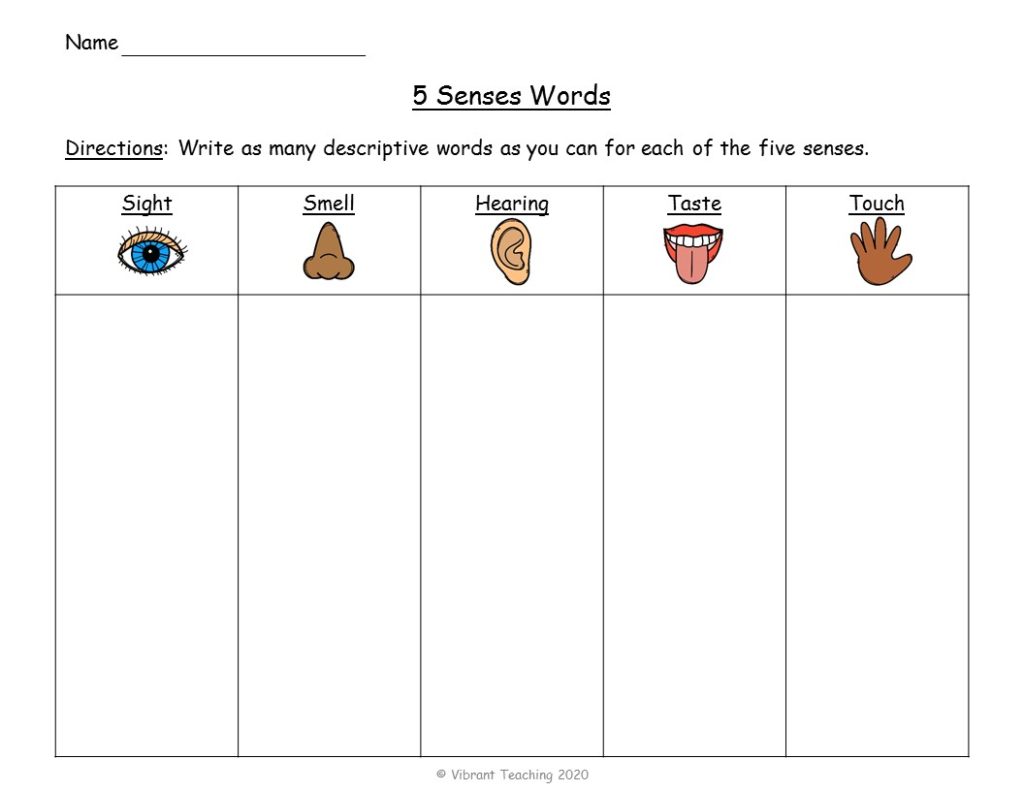
It’s fun to choose one topic and describe it in depth. Look at the list below for some examples of descriptive writing ideas for kids to try.
- Food – pumpkin pie, ice cream, hot chocolate
- Animal – dog, bird, elephant
- Season – winter, spring, summer, fall
- Holiday – Halloween, Thanksgiving, Christmas
- Place – zoo, island, school
- Event – birthday, parade, sporting event
Winter by Mrs. Sutton
Cold harsh wind engulfs me like a tornado.
White fluffy snow falls from the sky.
WHOOSH! The sound of the sled as it races past.
The smell of logs burning in the fireplace.
Sweet hot cocoa hits my tongue.

Autumn is Here by Mrs. Sutton
Bright vibrant red and yellow leaves.
The sound of leaves rustling in the wind.
Cool crisp air surrounds me.
The sweet smell of pumpkin pie as the warmth enters my mouth.
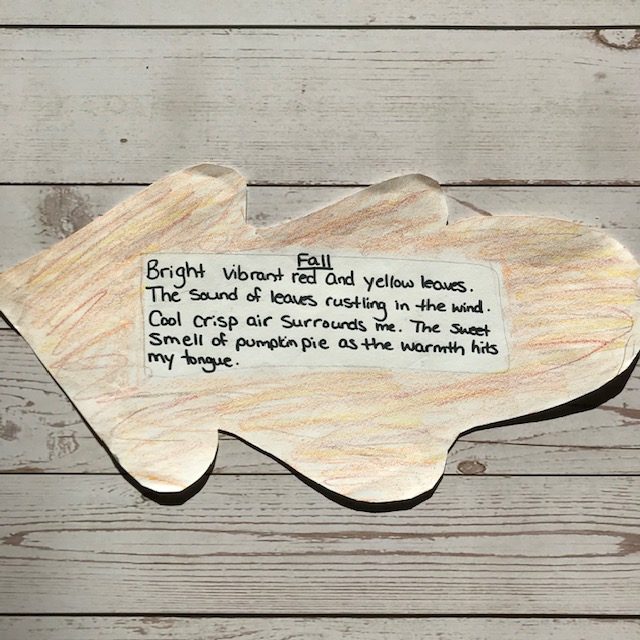
Mentor Texts
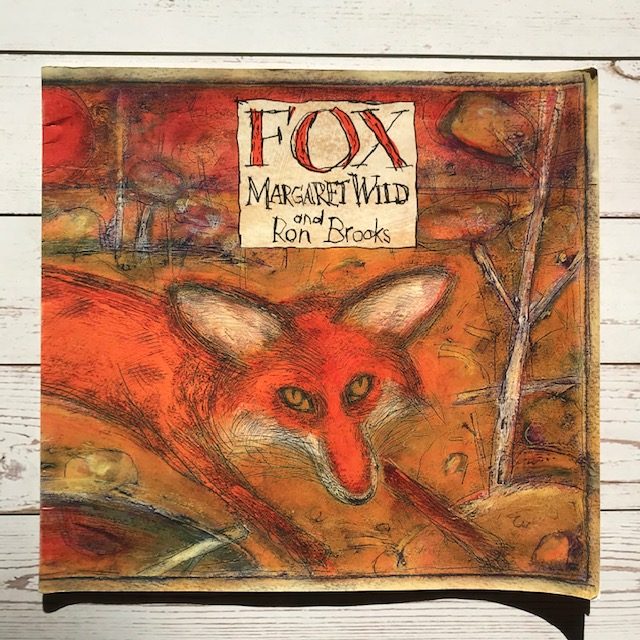
You Might Also Like:
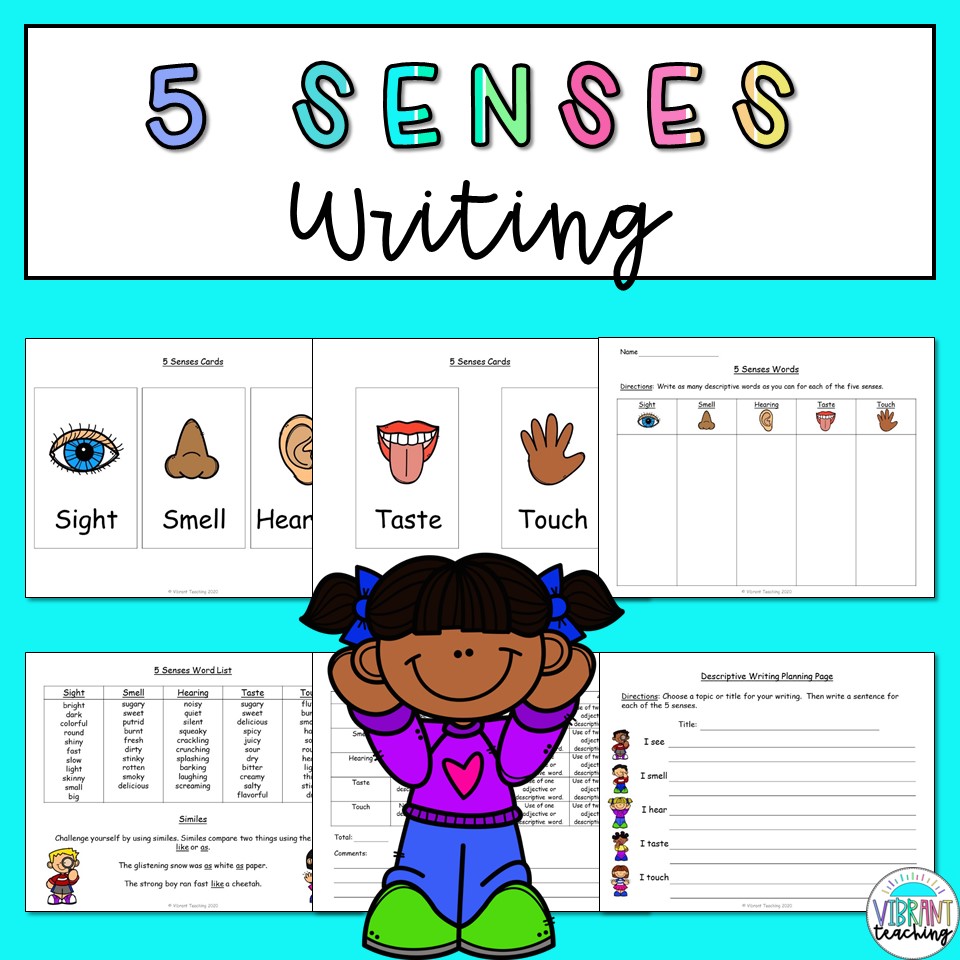
Vibrant Teaching is an Amazon Affiliate and receives a small commission for products purchased through these links. Thanks for your support !
Angela Sutton
Related posts.
How-To Writing Paper, Ideas, and Examples
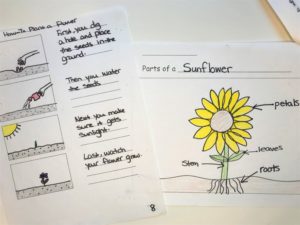
Informational Writing: Teaching All About Books

Monthly Writing Prompts to Engage Students and Make Writing Fun
Hi Angela, This article was really helpful for me. Thank you so much for the best resources given.
I’m so glad this information was useful and helpful. I really appreciate your feedback!
Leave a Reply Cancel Reply
I accept the Privacy Policy

I specialize in helping elementary teachers with writing resources, tips, and ideas. My goal is to save teachers time and energy so they can be vibrant inside and outside of the classroom! Read More
SEARCH THE BLOG
Subscribe to our mailing list.
Get the news right in your inbox!
Health and Wellness
Descriptive writing .
How to improve your descriptive writing.
Descriptive writing is an important literary device used in writing. It helps to create a detailed image in the reader’s mind about the characters, settings, and events in the story.
Writers often use the five senses in descriptive writing. The five senses are sight, smell, hearing, taste, and touch. There are many literary devices that writers can use to improve their descriptive writing.
Click here to learn about literary devices and how to use them in writing. An easy way to practice descriptive writing skills is to look at picture and try to describe it using language techniques.
Let’s look at an example:

I can see the green grass and the tall trees. I can smell the fresh scent of the blooming flowers. I can hear the birds chirping. I can taste the fresh air on my tongue. I can feel the wind blowing.
This description sounds repetitive and quite basic. We can improve this description by using a range of language techniques, interesting verbs, adjectives, and effective vocabulary. This will help to engage the reader, and it will help to create an image in the reader’s mind.
Here is the improved version: As I walk through the enchanted forest, I am greeted with the fresh smell of scented flowers. Their bright colours glow in the sunlight. Chirping birds happily dance around in the sky as the trees wave their arms in excitement. The warm spring breeze softly brushes against my face as I walk along the freshly grown grass. Slowly, the refreshing air lands on my tongue filling me with happiness.
So why is this description more effective? The reason is that there are various language techniques used.
• The use of the adjective “enchanted” suggests the forest is magical and fascinating • The use of the adjective “scented” allows the reader to almost smell the pleasant smell of the flowers. • The use of the verb “chirping” brings life to the picture, helping to create a feeling of happiness and delight. • By giving the trees a human quality such as “trees wave” further emphasises how vibrant and full of life the atmosphere is. This is an example of personification. • Personification is used again by giving a human quality to the breeze as it “brushes against my face” – the fact that it brushes against the face softly suggests that the weather is not harsh, rather it is pleasantly warm with cool winds. • Finally, the use of the verb “filling” emphasises the extent to which the narrator feels a sense of happiness and delight. As opposed to just saying “it made me happy” which doesn’t allow the reader to imagine exactly how happy the narrator is.
Let’s look at another example:

I can see the bright blue water and the golden sand. I can smell the fresh air. I can hear people talking and children playing. I can taste the saltwater on my tongue. I can feel my feet sinking into the soft sand. Again this description is quite repetitive and boring as it lacks language techniques.
Here is the improved version: Slowly, the bright blue sea crawls towards the golden sand. The fresh air enters my nose as I make my way down the seashore. With every step, I can feel my feet sink into the smooth sand, and the taste of the salty seawater lands on my tongue. The sound of the violin echoes along the coast as I begin to dance around on the sand elegantly. This description is improved through the use of effective verbs, adjectives, adverbs, and language techniques.
• The use of alliteration in “bright blue” draws attention to the sentence, helping to emphasise how vibrant and beautiful the sea is. • The use of the verb “sink’” suggests that the sand is so smooth, it almost absorbs anything that is placed on it. • The use of the verb “echoes” suggests that the beach is huge as the sound travels along the coast. • The use of the adverb “elegantly” creates a pleasant and graceful image that reflects the surroundings.
Now you try! Take a look at this picture and try to describe it using language techniques.

Then watch the video to find the example description.
Watch the video
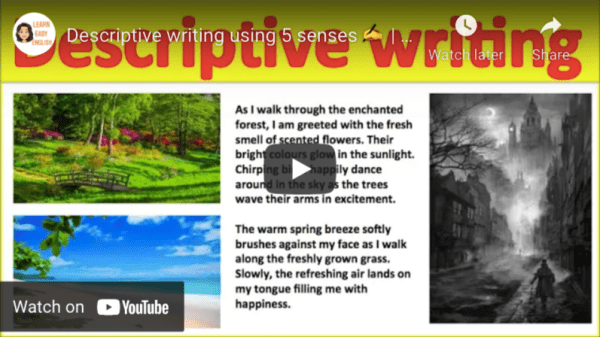
Online tutoring to ensure you remain proficient in English, Maths, and Science.
Enjoy learning with ilearneasy.

Descriptive Paragraph
Ai generator.
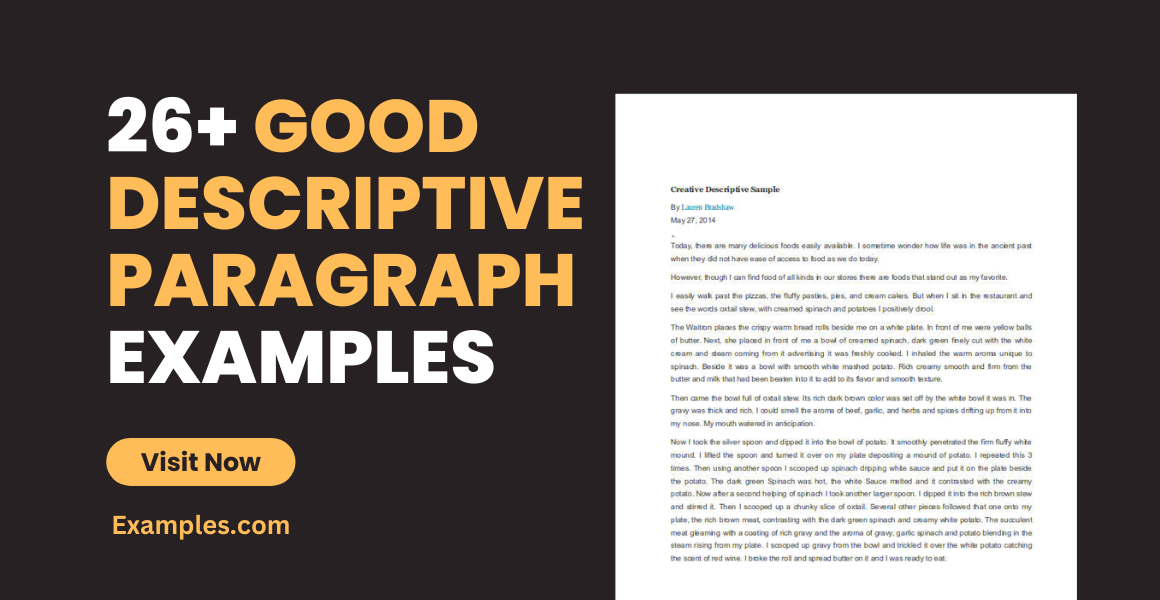
To compose an impressive descriptive paragraph, it is important to take note that the main purpose of your writing is not to plainly describe but to paint a picture out of your words. Though it may sound confusing, discovering the deeper world of descriptive writing will surely clear things up. In this article, we are going to discuss the fundamentals of descriptive paragraphs and help you write a magnificent composition of your own. Read through to learn more.
There are various ways to apply descriptive writing and write a descriptive paragraph. Before starting with the proper lecture, we gathered some samples to give you a broader overview of developing your descriptive writing skills . Take a look at these samples:
Descriptive Writing Essay Template

- Google Docs
Size: 185 KB
Short Descriptive Writing
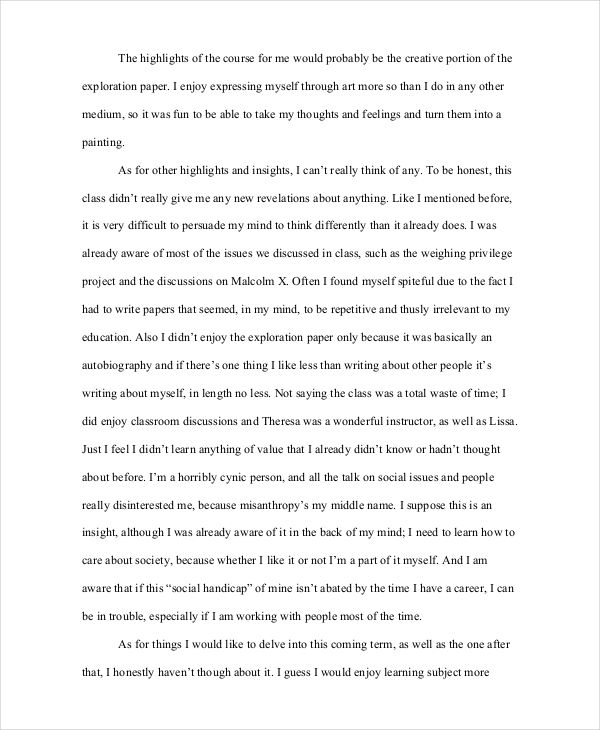
Creative Descriptive Sample
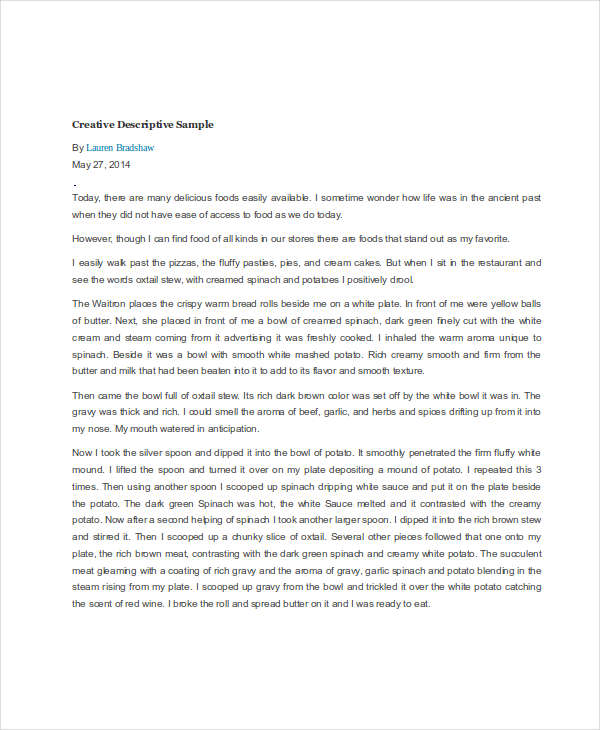
What Is Descriptive Writing?
Descriptive writing is a writing style which is used to describe in sensory detail the different things, places, people, and ideas. Descriptive writing sketches an image on the reader’s mind by giving a detailed description of the particular topic or subject. By doing this, the writer creates a vivid image of whatever he/she is writing about, and allowing the reader to imagine such an image while reading the composition. These are applied in different literary works such as novels, stories, and metaphoric poems .
What Are Some Examples of Descriptive Writing?
Basically, descriptive writing is creating a picture and scenes out of the descriptive sensory details stated by an author about a certain topic. Now that you already have a broader overview of what is descriptive writing, let’s discuss some documents or literally works that apply practical utilization of this type of writing.
Descriptive Essay
A descriptive essay is a literary form that aims to describe a certain subject such as objects, places, experiences, people, etc. Needless to say, descriptive writing is applied in this composition because it enables authors to use adjectives that incorporates the senses such as touch, taste, hearing, smell, and sight to paint a portrait of the mentioned scenarios in the reader’s mind.
Novels are extensive fictional narrative works that are commonly written in prose form. These often deal with complex human experiences that are incorporated with a sequence of events and various characters and settings. Novels are also dissected into different types such as mysteries, thrillers, historical, suspense, crime fiction, science fiction, romantic, etc.
Short Story
Short stories are greatly alike to novels; however, these pieces are significantly shorter and less intricate. The adjective “short” in short stories does not really mean brief, but it shows that these works have a limited scope of settings and characters. In fact, a prominent American humanist, Charlotte Perkins (Stetson) Gilman, composed a long short story that is written on about 19 pages. The short story is entitled “Insidious.”
These are still more kinds of literary pieces that involves descriptive writing in the process such as scripts, descriptive dictionaries, poems, feature articles and many more. Remember that descriptive writing is a literary device, not a classification that defines the whole context of a text. Thus, do not be confused if descriptive writing is applied in a narrative, alright?
Free Descriptive Writing

Size: 19 KB
Workshop Descriptive Writing
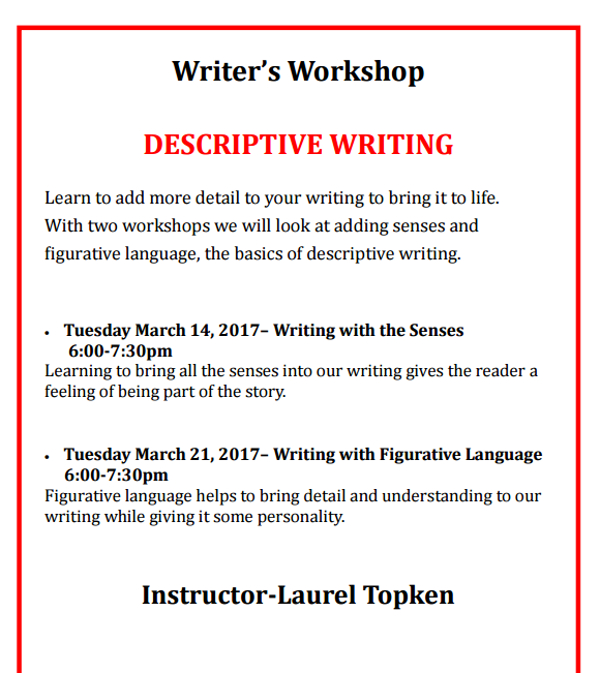
Size: 469 KB
Simple Descriptive Writing
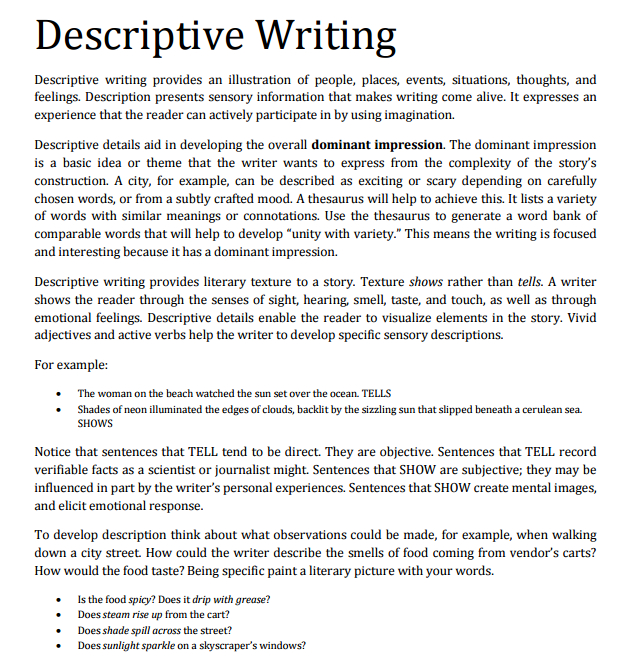
Size: 522 KB
Printable Descriptive Writing
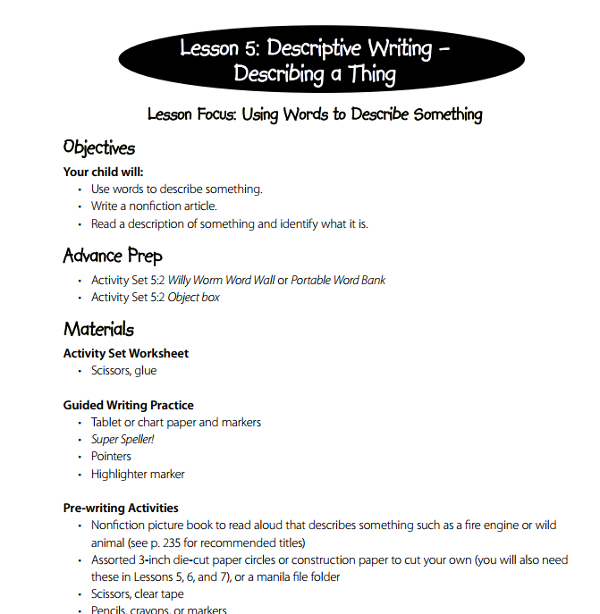
How to Start a Descriptive Essay?
Writing a descriptive essay is pretty easy because basically, you only need to describe something with the use of words that collaborates with the five senses. However, to make a compelling and interesting composition that people would read through the last punctuation is indeed a terrific challenge. If you want your readers to continue reading the whole essay, you need to be critical with your introduction first. To help you make an alluring intro, you may follow these steps.
1. Consider your topic.
Topics are usually decided before focusing on your introduction. Now that you have a specific topic you want to describe, make sure that your topic is within the set criterion (if there is any) and truly interests you. Your topic will be the basis for your thesis statement which will also be the key topic of the whole essay so choose the finest topic you can pick.
2. Consider your target readers.
Before writing a single alphabetic character, give yourself some time to ponder on who do you want to be the reader of your work. To do this you may try to meditate and think on the question, “If your essay was a speech, who would be your listeners?” Also, do not forget to align your audience to your topic. For example, if you want to describe “family planning” then do not expect grade school students to be your target reader. By doing this, it would be easier for you to identify what language and style type you must apply in your essay.
3. Write statements about your topic.
In this step, we will be needing your pen and paper now. Once you already have them, kindly write any random statements that are relevant to your topic. You may make three to four statements in which all revolve around your main topic. If your topic is something you are very familiar with, you can make use of your own personal experience. For instance, assuming that you want to describe your summer vacation, you can craft a statement like “This essay describes my short stay in Hawaii last summer vacation.” After you have made adequate numbers of sentences, choose the best one. This will serve as your thesis statement.
4. Write some things your reader will learn.
In this step, you need to specifically mention or depict three to four things that your reader will learn upon reading your essay. Make sure these also relate to your thesis statement. Take note of these lessons and utilize the same format in writing them such as:
- Readers will learn how fun my summer vacation was
- Readers will learn what are the superb experiences I encountered in Hawaii
- Readers will learn what are the great places I visited in Hawaii
- Readers will learn what makes the beaches in Hawaii great
These will serve as your topic sentences.
5. Summarize your topic sentences.
Write down all your topic sentences in summary form. A while ago, the same format was used; however, for this part, remove all of them. If you take a hard time to do this, reading the paragraph you have constructed aloud would be a great help.
6. Create your introduction.
Now is the time to make your final intro. Simply craft a summary paragraph of the statements you have stated a while ago. Also, apply variety and creativity in your recapitulation to make the paragraph flow smoothly. Commonly, you can mention your thesis statement in the final part of your introduction.
For experts, you might not need this chronological sequence of steps; nonetheless, for beginners who are unconfident with their composition, relying on this section will never be a bad idea. You can apply it as many as you can until you don’t need it anymore.
Importance of a Descriptive Essay
The basic aim of a descriptive essay is to show the readers, and not simply tell them the details through a thorough description. Descriptive essays let the writer connect better with his/her readers. In descriptive writing, the writer stimulates the readers’ imagination through vivid descriptions of the subject. You may also see formal writing examples & samples .
Thus, it is important for the writer to be observant of the details while being creative and imaginative at the same time. It is hard to capture a reader’s attention and keep it until the end of a story, but a well-crafted descriptive effective essay is able to do both things at the same time.
Through descriptive writing, the reader will be able to recreate images on their minds and feel emotions being depicted in the composition. Therefore, the writer must avoid using vague words and descriptions in writing an essay for descriptive.
Plain Descriptive Writing

Size: 51 KB
Teaching Descriptive Writing
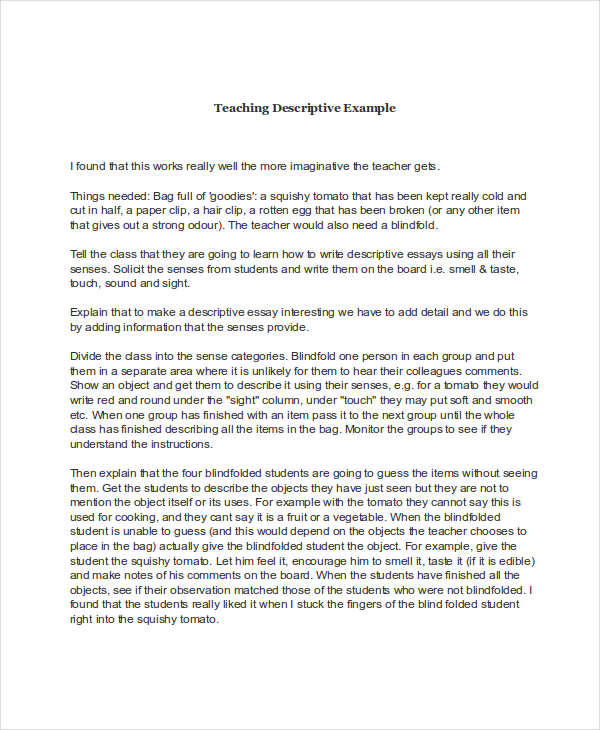
General Descriptive Writing

Size: 60 KB
Personal Descriptive Writing

Civil War Letters Descriptive Writing

Size: 127 KB
Teaching Descriptive Writing
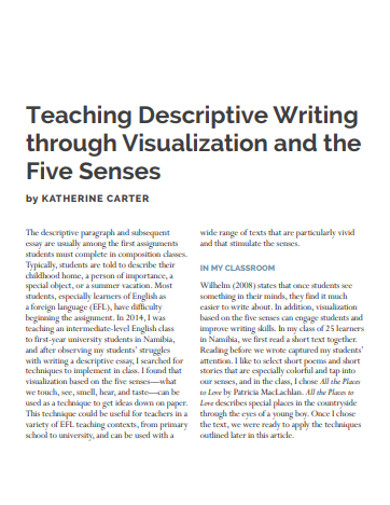
Size: 424 KB
Teacher Descriptive Writing Example
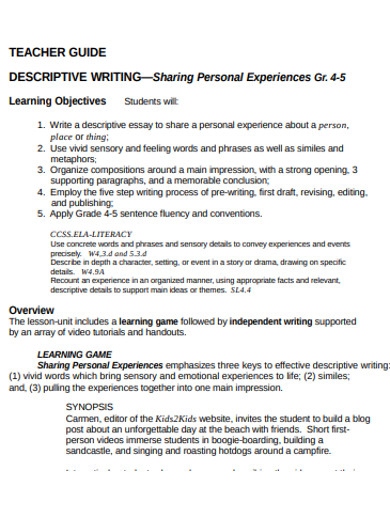
Size: 166 KB
Master Descriptive Writing
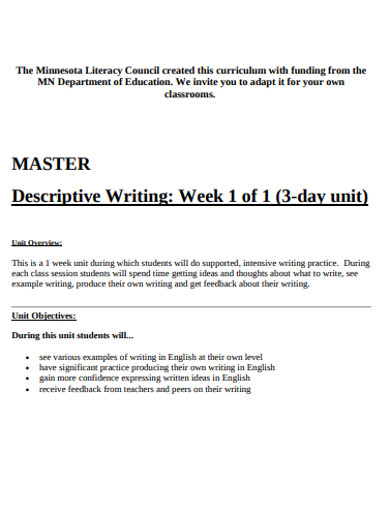
Size: 154 KB
Lesson Descriptive Writing
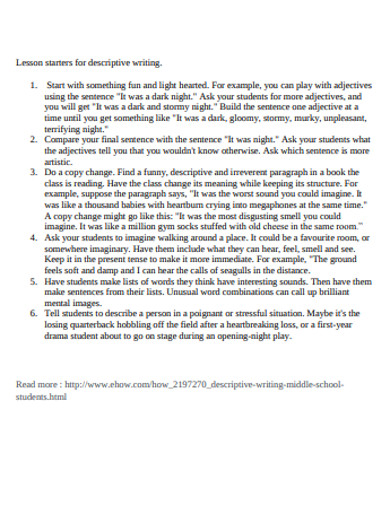
Size: 144 KB
Student Descriptive Writing
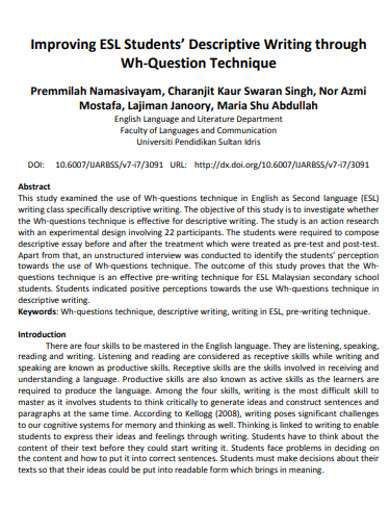
Size: 573 KB
Police Officer Descriptive Writing

Size: 22 KB
Descriptive Writing Example
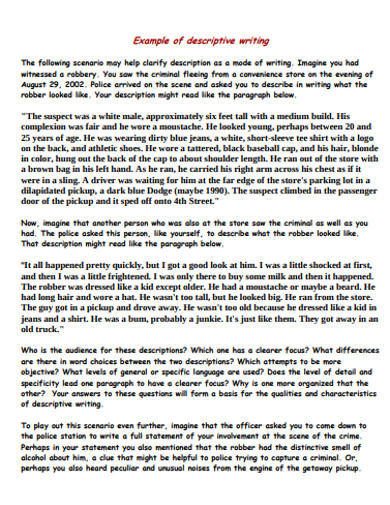
Size: 25 KB
Sample Descriptive Writing

Size: 337 KB
Printable Descriptive Writing Example

Size: 215 KB
Descriptive Writing in PDF
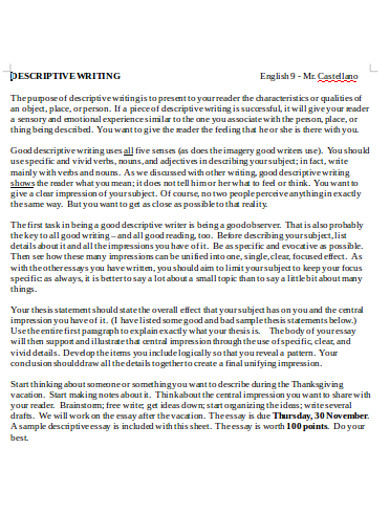
How to Write a Descriptive Paragraph?
Essays are made up of integrated paragraphs. A paragraph is an independent unit of writing a discussion that deals with a specific point or topic that are used to organize longer prose. In its formal sense, paragraphs are consist of one or more sentences and should carry a topic sentence. Similar to essays, paragraphs can also vary according to their purpose. In this section, we are going to give you steps on how you can write a descriptive paragraph.
1. Begin with your topic sentence or interesting idea.
In writing each paragraph it is important to keep it interesting, especially if it is the introduction or the lead of a document. To do this, one can start with a topic sentence. This sentence holds the key idea of the whole paragraph or states what the paragraph is all about. For example, if your topic sentence is “Watching the warm orange sun as it sets from the horizon of the bay makes my eyes misty.” then the whole paragraph simply takes about this specific idea. You can discuss the reason why you act that way or basically anything that supports this sentence.
It is effective to begin your paragraph with the topic sentence because it would establish expectation to your audience what this paragraph is all about at the very opening sentence. Also, it would be a lot easier for you to compose since the following sentences are already guided with the topic you have mentioned. If you want a different approach, you can utilize any interesting detail as your introductory sentence.
2. Support with interesting details.
As mentioned earlier, a topic sentence is supported with relevant details. These sentences or ideas will act as your building blocks to build a concrete message to your reader. Since each paragraph holds different topics, there are also numerous ideas you can include. For example, if you are describing a person, you can elucidate on his appearance and personality. If you are giving a description of an object, you can talk about its size, shape, texture, color, etc. On the other hand, if it is a place that you want to describe, you can add some details about how you feel about the place or the most striking element of the area. Remember, in adding supporting details, only include the most important information about your paragraph to avoid confusing your readers.
3. Include sensory details.
In order for you to make your descriptive paragraph more compelling, it is important to use sensory words. These are the details that incorporate your senses such as sight, hearing, smell, touch, and taste to create a picture of your experience that your reader could also imagine. This also greatly helps notably if you are going to describe something unknown to the common.
There are various sensory details that you could use to improve your description. For example, rather than stating “I love the air of the province.”, you can express this sentence into “I love the soothing fresh air of the province as it calmly enters my nostrils.” By simply adding sensory details, you can upgrade a plain sentence with no fuss.
4. Include figurative language and compelling adjectives.
Figurative languages are the tool that writers use to establish a creative way of expression apart from the conventional and formal order of writing. These create complex meaning, colorful writing, indirect comparison, and clarity. In writing your own paragraph, it is important to use figurative language in the process.
There are several figurative languages that you can utilize such as metaphor, simile, personification, hyperbole and a whole lot more. Moreover, in using them, make sure to apply them correctly and do not overuse these tools, too. On the other hand, using strong adjectives can also enhance the appeal of your works. Considering that descriptive paragraphs are more on describing, it would be helpful for you to learn the nature of adjectives or describing words.
5. End with a terminating conclusion.
As beautiful as your intro, your conclusion should be considered well, too. In ending your paragraph, it is important to have a clean, nice and smooth exit. You can do this by stating the significance of an object or an event that closes your story. Before ending your paragraph, also make sure that you already expressed the complete total message you want to convey before stating your conclusion.
What Is an Example of a Descriptive Paragraph?
In the field of journalism, a lead or lede is considered as the sentence or paragraph that contains the essential information of an article. It also sets the tone and alures people to continue reading the whole content. Moreover, leads are commonly used as an introduction.
Apart from hard-news leads that are commonly briefly written with pieces of information bearing the who, what, when, where, when, why, and how of a story, there is a kind of lead that allows a writer express a story creatively. This lead is what we call a feature lead or delayed lede. It allows a writer to create a scene, describe a subject or tell a short story or anecdote. Furthermore, descriptive writing is also applied in this paragraph.
Difference between Narrative and Descriptive Writing
In school, we learned to write different compositions on the different types of writing styles.
Narrative and descriptive writing are two of the writing styles we’re already familiar with. However, because of their similarities, some are still unable to differentiate both styles from each other. You may also see what is writing used for?
Basically, narrative writing is a narration of an event or a particular experience, while descriptive writing is a description of a certain topic. Still, let’s dig deeper.
1. In narrative writing , the writer recreates a particular memory of experience through by the sequence of events in chronological order. Narrative writing retells events in detail, creating a story out of it. Narrative writing aims to tell a story to its readers. It also includes the basic elements of the story, such as characters, plot, setting, among others, and is often written in the first person or third person point of view.
2. In descriptive writing, the writer illustrates an image of the subject being described. The writer often relies on the human senses upon describing things, places, events, people, feelings, or ideas. This enables the reader to easily visualize the image, as described by the writer. You may also like essay writing examples & samples .
What Are the Types of Descriptive Writing?
Descriptive writing is essentially about describing a subject; however, subjects in a descriptive text differ from each other. Because of this variety, here are the three major types of descriptive writing:
1. Descriptive writing about a person
This type of descriptive writing generally talks about an individual or group of individuals. It creatively discusses the personality, the characteristics, the demographic information and appearance of the described person. In this type of descriptive writing, mentioning details pertaining to the physical feature of an individual is advisable since it is one of the first characteristics that people usually observe first, and it creates an emotional appeal to the reader.
2. Descriptive writing about an object.
Needless to say, this type of descriptive writing depicts an object. In writing a descriptive statement about a thing or object, it is important to make use of the five senses. Treat your readers as innocent children, as if they never met before the object you are describing. For instance, instead of saying “The jacket that Betty uses is nice.”, you can state as “The pink soft furry hoodied jacket that Betty uses is so fantastic.” Since object-related topics commonly hold less emotion, using metaphorical terms would also help in appealing your readers.
3. Descriptive writing about a place
One major type of descriptive writings is about places. This basically features the place but also encompasses everything around and in it. Details are an important factor in this writing since it is like creating a landscape painting with the use of words. You can often start with the most fascinating characteristic of the place or your first or total reaction upon visiting or seeing the place. You can also add some dialects or bizarre qualities of the region or scenery as well.
Text prompt
- Instructive
- Professional
10 Examples of Public speaking
20 Examples of Gas lighting

IMAGES
VIDEO
COMMENTS
Use your senses to take note of what you see, hear, smell, taste, and touch. Write down your observations. Choose one of the things you noticed on your walk and use it as a prompt for your writing. For example, if you noticed the sound of birds chirping, write a descriptive paragraph that captures that sound.
Descriptive Essay Example 5 Paragraph. 5 paragraphs essay writing format is the most common method of composing an essay. This format has 5 paragraphs in total. ... Descriptive essays are the best option when it comes to describing and writing about a person. A descriptive essay is written using the five human senses. It helps in creating a ...
Feel. Of all the cinque sense, touch is, in my view, one of the most powerful even underrated ones. If you can convey touch in einen effective way, you'll reap the rewards. 1 sighting · 2 smell (olfactory) · 3 taste · 4 touch · 5 hearing. On the whole people has this sets senses. · 6 perception · 7 sense of pride.
Descriptive essay writing will require you to use your five senses. This type of essay will help you explore your sense of taste, sight, touch, smell, and sound. For example, when describing your favorite life memory, a complete description may include the appearance of the buildings, the laughter of your friends, the smell of the flowers, and ...
An example of a short descriptive essay, written in response to the prompt "Describe a place you love to spend time in," is shown below. Hover over different parts of the text to see how a descriptive essay works. Descriptive essay example. On Sunday afternoons I like to spend my time in the garden behind my house.
To really create descriptions that will stay with your reader and improve your writing skills, you'll need to learn how to describe the sensory details of all five of your senses. Description is one of the most basic tools in a writer's toolkit. You can't get very far in a story, a poem, or a narrative essay if you can't convey what the ...
5. The Sense of Touch. Like all five of the senses, the sense of touch can be painful or pleasurable. Make it pleasurable, like the feel of cool cotton sheets, and the readers will experience the pleasure along with the character. Make it painful, like being head butted in the nose, and the readers will wince.
Make sure that your essay includes the five senses, touch, taste, smell, sight, hearing, or at least one of them. It depends on the topic and the kind of feeling that you want to arouse. ... Descriptive Essay Examples. Study these descriptive essay examples and sample papers to understand the main idea, structure, and purpose of descriptive essays.
Descriptive Essay Examples. In this section, you'll discover essay examples that demonstrate how to captivate your readers' attention effectively. ... It aims to create a sensory experience for the reader by appealing to the five senses: sight, sound, smell, taste, and touch. Descriptive essays often use imagery and descriptive language to ...
Example Audience: In this particular essay, the writer wants to show an outsider to the state why Minnesota natives are so happy to live there. ... Also, check to see if your descriptions have made use of all of the five senses: sound, smell, texture, sight, and taste. Repeat these steps as many times as necessary until you are happy with your ...
Descriptive essays breathe life into words by painting a vivid picture of a person, place, thing, or experience. They employ sensory details and expressive language to make the subject come alive for the reader. Here's a basic yet effective structure you might use when crafting a descriptive essay: 1. Introduction.
Sensory Details: Descriptive writing relies heavily on details that appeal to the five senses (sight, sound, smell, touch, and taste) to create a tangible and immersive experience.
Like every essay sample, a descriptive essay has an outline and format. The essay follows the traditional essay structure and includes: 1. An Introductory Paragraph. The first paragraph of an essay is the introduction and it usually sets the mood for the entire essay. A good descriptive essay has a strong opening.
A descriptive essay, as the name implies, is a form of essay that describes something. In this genre, students are assigned the task of describing objects, things, places, experiences, persons, and situations. The students use sensory information to enable readers to use their five senses of touch, taste, smell, hearing, and sight to understand ...
By including tactile details, you engage your reader's sense of touch, making your descriptions more immersive and realistic. 4. Utilize Feeling Words. Now, let's dive a bit deeper. Sensory words help your reader visualize, hear, and feel the physical aspects of your description.
Remember: Five, four, three, two, one . . . Write! References to all five senses complete the description of your story's setting, so the next time you take a walk, take a writing pad, too, and make this "five senses" exercise part of your creative writing work-out! Learn more about Teen Writer! and other Luminari camps for teens at
This type of paper requires students to engage all the five senses of the reader, that is, sight, sound, smell, touch, and taste using literal tools, which we will discuss in detail in this article. ... The best descriptive essay examples that you will come across use illustrative language to describe the topic rather than the authors ...
For example, in describing a person, it may be possible to make the reader see, hear, smell and touch the person. In describing a scene or object, it may be possible to evoke responses from all five senses. A good starter is to form word lists for each of the senses relevant to the given subject. The words can then be crafted into sentences ...
The Best Examples Of The 5 Senses And Descriptive Writing. Using the 5 senses in writing can deeply immerse readers in scenes and stories by creating more vivid imagery in their minds. It's a skill that can elevate books to a higher level. But so often we writers find ourselves lured into the trap of relying on sight and sound.
Descriptive writing uses details and the five senses to describe a person, place, thing, or event. Proper word choice and the use of adjectives are very important for the reader to create a picture in their mind. Similes and onomatopoeia (sound words) are some other examples of descriptive writing. Basic Sentence: The leaf fell off the tree.
Sight, smells, and hearing are senses that are more commonly used, because we perceive most of the world with these three senses. Taste and touch are not employed as often, because what we taste ...
Descriptive writing is an important literary device used in writing. It helps to create a detailed image in the reader's mind about the characters, settings, and events in the story. Writers often use the five senses in descriptive writing. The five senses are sight, smell, hearing, taste, and touch. There are many literary devices that ...
Lesson Plan. Explain to students that they are going to use all five senses as they write a descriptive paragraph. Ask students to list the five senses, and write them -- sight, hearing, taste, smell, and touch -- on a chalkboard or chart as students respond. You might prepare in advance of the lesson a work sheet with a 5-column chart; each ...
Write down all your topic sentences in summary form. A while ago, the same format was used; however, for this part, remove all of them. If you take a hard time to do this, reading the paragraph you have constructed aloud would be a great help. 6. Create your introduction. Now is the time to make your final intro.